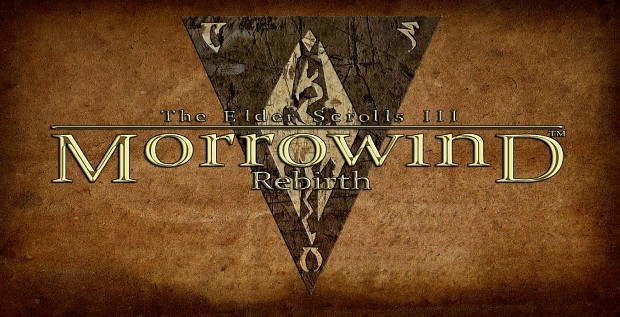Ronald.phillips
Shared posts
Armenian Entities Hit by New Version of OxtaRAT Spying Tool
These Anime Shows Are Now Free to Watch on YouTube - CNET
Hackers Earn $180,000 for ICS Exploits at Pwn2Own Miami 2023
White hat hackers received $180,000 at Pwn2Own Miami 2023 for exploits targeting widely used ICS products.
The post Hackers Earn $180,000 for ICS Exploits at Pwn2Own Miami 2023 appeared first on SecurityWeek.
SolarWinds Announces Upcoming Patches for High-Severity Vulnerabilities
SolarWinds advisories describe multiple high-severity vulnerabilities that a Platform update will patch by the end of February.
The post SolarWinds Announces Upcoming Patches for High-Severity Vulnerabilities appeared first on SecurityWeek.
Security Experts Warn of Foreign Cyber Threat to 2024 Voting
Top state election and cybersecurity officials warned about threats posed by Russia and other foreign adversaries ahead of the 2024 elections
The post Security Experts Warn of Foreign Cyber Threat to 2024 Voting appeared first on SecurityWeek.
‘Frebniis’ Malware Hijacks Microsoft IIS Function to Deploy Backdoor
The Frebniis malware abuses a Microsoft IIS feature to deploy a backdoor and monitor all HTTP traffic to the system.
The post ‘Frebniis’ Malware Hijacks Microsoft IIS Function to Deploy Backdoor appeared first on SecurityWeek.
NPR asks the question: Is corporate America going to care about Americans' desire for basic privacy rights to be protected when it comes to using AI to profit off them? Narrator: No [Obvious]
The Best Linux 6.2 Features From Intel Arc Graphics To Better Performance For Older PCs
FBI says it has 'contained' a cybersecurity incident on its network
The FBI is dealing with another attack on its digital infrastructure, although the severity isn't yet clear. The law enforcement agency tellsCNN it has "contained" a recent cybersecurity incident on its network. The bureau isn't commenting on the perpetrator, scope or damage, but says it's gathering "additional information."
Sources speaking to CNN claim the intruders targeted a system used to investigate child sexual abuse material (CSAM). The incident involved the high-profile New York Field Office, according to the insiders. Investigators are said to still be investigating the origins of the breach.
This isn't the first such incident in recent memory. In November 2021, an attacker compromised FBI email servers and sent thousands of messages falsely claiming recipients were victims of data breaches. The campaign tried to blame the imaginary attacks on dark web security firm operator Vinny Troia. The FBI never named a culprit, but did patch the flaw that allowed the intrusion.
This may not necessarily be a serious violation. Other campaigns, such as the 2020 Treasury breach and the SolarWinds hack, are known to have exposed sensitive email contacts for officials. Still, the data reportedly at risk makes the attack concerning, even if the impact may be relatively limited.
More Than 350,000 ‘Self-Driving’ Teslas Unsurprisingly Recalled

Tesla is voluntarily recalling 363,000 of their vehicles in the U.S. due to safety risks stemming from its latest ‘Full Self-driving’ (FSD) Beta software update. FSD can be used to drive the Teslas on local roads, accelerating and braking accordingly based on what it detects with its cameras. However, the system is …
Keanu Reeves Had To Push For The Pencil Fight In John Wick 2
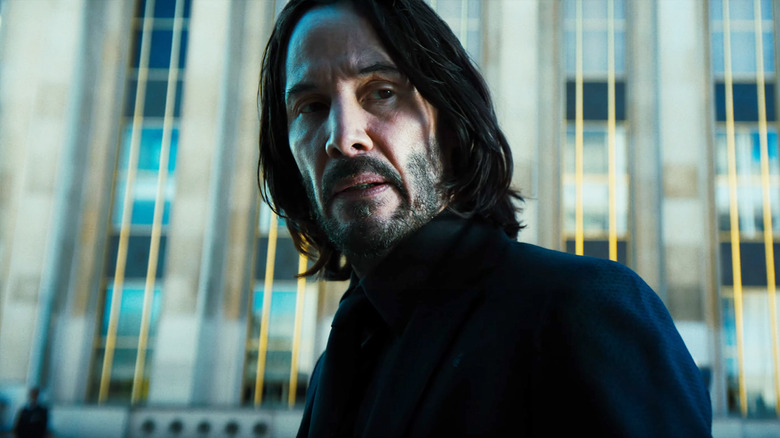
John Wick is basically invincible. Over the course of his action franchise, Keanu Reeves' hitman has proven his impossible toughness by dispatching wave after wave of faceless thugs with the distinct John Wick gun-fu for which he's so well-known. And whereas the first movie showed at least some deference to plot and humanizing its titular assassin, as the saga has progressed, he's become much more of a one-dimensional badass.
None of which is all that surprising. Franchise director Chad Stahelski is, after all, a stunt performer and choreographer, which means the action sequences were always going to take precedence. Both Stahelski and his co-director on the first movie, David Leitch, have previously said the right things about directing, telling ActionElite.com that "the good, big-budget action directors know that action is just another part of the process, like acting and performances." But in reality, the John Wick movies have slowly become showcases for the balletic gun-fu scenes they conjure up.
This isn't necessarily a bad thing. After "John Wick," Stahelski took over solo directing duties for the follow-up and doubled down on the central character's pre-eminent fighting skills, synthesizing the most undeniably cool parts of the first entry. As he told iNews, when planning the sequel, he and Reeves simply decided to not "worry about plot" and "just stay with the guy, open up the mythology, push the action even further." And as "John Wick: Chapter 2" came together, they found that the mythology actually informed the action -- especially with one specific fight scene.
Myth To Reality
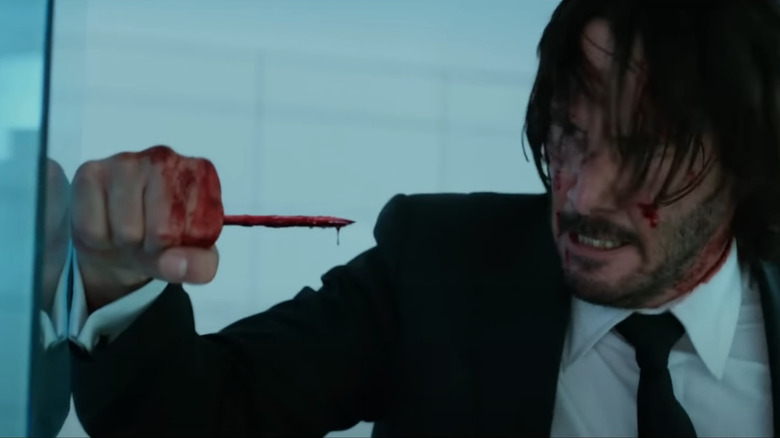
The action movie majesty of the "John Wick" series has always been its main draw, but it's made even more effective by the mythology behind the titular character. Baba Yaga, the boogeyman, is an assassin so feared by the criminal underworld that even the most heartless crime lords tremble at the mention of his name. In "John Wick," it was Russian mafia boss Viggo Tarasov (Michael Nyqvist) who tells his son that Wick is "the one you send to kill the f***ing boogeyman" and that he once saw Wick "kill three men in a bar with a pencil." For the sequel, Stahelski and the team needed to remind people why Baba Yaga is so feared. That meant kicking off proceedings with a similar speech, this time delivered by Abram Tarasov (Peter Stormare), Viggo's brother, who repeats the pencil line.
For Keanu Reeves, whose dedication to performing almost all of Wick's fight scenes and stunts borders on obsessive, he simply had to see that particular aspect of his character's mythology in action the second time around. He relayed how he was adamant that the pencil had to make it into "John Wick: Chapter 2," via Page Six: "Chad is so interested in not just action, but the character in the action, and what's the storytelling. In the second [film], I really fought for getting the pencil fight. It was talked about in the first one and I was like, 'Guys, we gotta do a pencil fight!'"
With Reeves pushing for some pencil action to make it into the movie, Stahelski went ahead and planned a now-famous sequence in which Wick gruesomely dispatches two assassins with the writing utensil in the entrance to a subway station.
Show Don't Tell
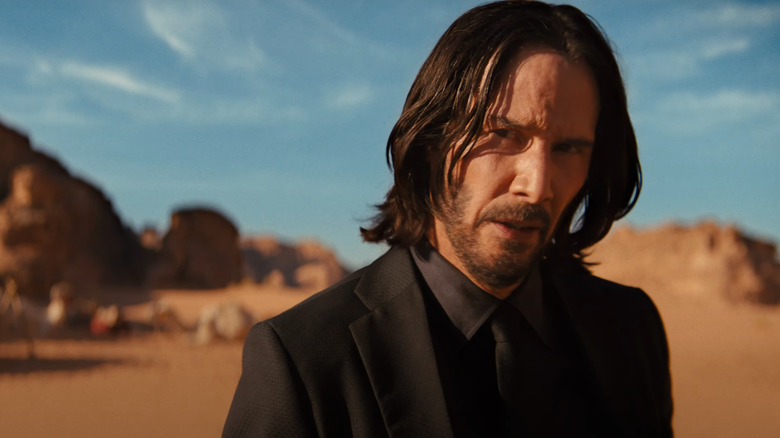
Stahelski has spoken about wanting to convey the skills of John Wick in as believable a way as possible. Part of that has involved intense training for Keanu Reeves, allowing him to perform most of the on-screen action, then using long, unbroken takes during filming to enhance the believability that Reeves is actually as capable as Wick. The director told iNews:
"We find that the best way to fake being good is to actually be good [...] It's why I use so many long takes. I want the audience to know it's Keanu doing this stuff. There's that video of him on YouTube shooting live rounds and he's not faking it; he's actually shooting, and he's nailing targets. He's the nicest guy in the world, but if he had to? I'm sure he would be able to kill you with a pencil pretty quickly."
That focus on enhancing the believability of the fight scenes is all-important when the overall premise of a near-invincible assassin who can fend off armies of combatants is, in and of itself, pretty unbelievable. By actually showing John Wick using a pencil to kill, the director is extending that approach to the world and mythology of the film, actually showing you what Wick is rumored to be capable of.
By this point, the character of John Wick has more than proven the truth of the mythology surrounding him, and for the upcoming "John Wick: Chapter 4," it seems Stahelski has thrown out the standard formula in an effort to try something new. But you can bet there'll still be non-stop, highly-choreographed, and expertly-executed violence, which should make for an epic face-off between Wick and Donnie Yen.
Read this next: The 14 Greatest Action Movies Of The 21st Century
The post Keanu Reeves Had To Push For The Pencil Fight In John Wick 2 appeared first on /Film.
[RELEASE] Morrowind Rebirth 6.2
![[RELEASE] Morrowind Rebirth 6.2](https://media.moddb.com/cache/images/downloads/1/246/245747/thumb_620x2000/Morrowind_Rebirth_Menu.6.1.jpg)
This is the full version of Morrowind Rebirth 6.2.
Star Trek: Picard's Terry Matalas On Creating 'A Different Kind Of Captain' Just For Todd Stashwick [Exclusive]
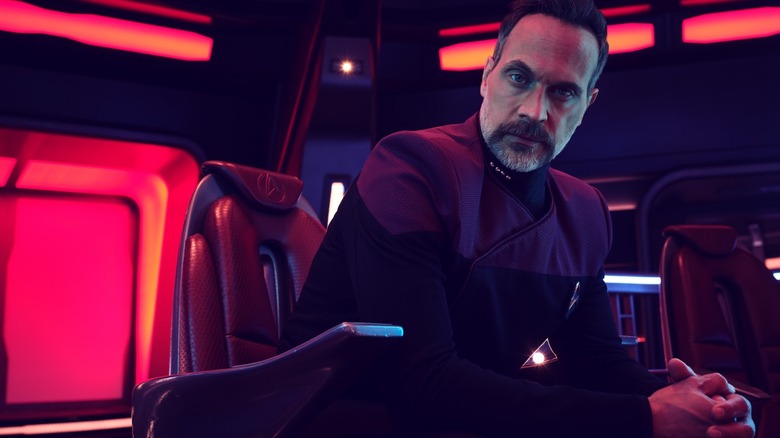
If a viewer's only experience with Starfleet captains is Capt. Jean-Luc Picard (Patrick Stewart), one could easily get the impression that everyone in that position is stalwart, professional, clear-headed, and just the right blend of aloof and approachable. Picard was always a stern professional, leading by example and professionalism. He was hardly warm but indicated that he was always open to listening to his crew's suggestions during a crisis. Picard is like the college professor you don't want to disappoint — it feels good to earn his approval because you know his standards are high.
Of course, several of Picard's professional peers take a very different approach. Capt. Sisko (Avery Brooks) had a short temper and led through heated debate. Sisko was a more passionate captain than Picard, lacking in patience and less worried about propriety. Capt. Janeway (Kate Mulgrew) was seemingly warm, but over the course of "Star Trek: Voyager," revealed herself to be something of an authoritarian. And then there was Capt. Jellico (Ronny Cox), the commanding officer of the Enterprise-D when Picard was kidnapped by a Cardassian torturer. Jellico demanded formalism and propriety. He was cold, curt, the opposite of jocular. And he never conversed socially.
The great thing about all these characters and their varied command styles is that there was no "right way" to be captain of a starship. There were just different ways to manage. In true "Star Trek" fashion, a new perspective is exciting and welcome ... even if we wouldn't like the character personally.
Capt. Liam Shaw (Todd Stashwick), newly introduced on "Star Trek: Picard," provides yet another welcome and exciting command perspective: what if a starship captain was kind of an a-hole?
Capt. Liam Shaw
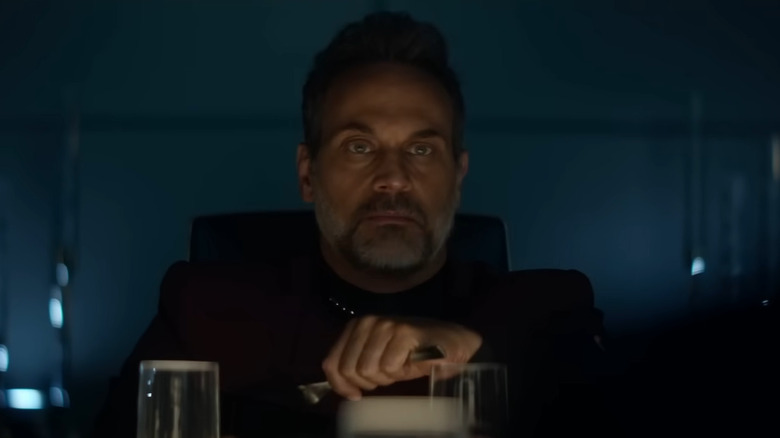
/Film's own Vanessa Armstrong recently spoke with "Star Trek: Picard" showrunner Terry Matalas about Capt. Shaw and the dynamic the new character brings to both the show and the franchise at large. Matalas knew Stashwick from his TV adaptation of "12 Monkeys," and actively created, with the other "Picard" writers, a character that wouldn't just stand in the way of Picard in terms of plot, but stand opposite him in command philosophy. Matalas said:
"Todd was on my last show, '12 Monkeys,' which was a four season show that was also my baby. When we got in the writers' room, some of those writers are also in this writers' room, and we knew we wanted to create a different kind of captain, a kind of blocking character for Riker and Picard. We thought it would be fascinating to see them throw around their Starfleet weight, and then suddenly there was a guy who was like, 'I don't give a s*** about you.'"
Riker (Jonathan Frakes) and Picard, it should be noted, are older, retired Starfleet officers in "Picard," and aren't on active duty. They are respected for their past careers and their "elder statesman" status, but Shaw sees them as last-minute guests on his ship, the USS Titan-A. Picard and Riker are forced to sleep in bunks and have no sway when it comes to command decisions. Capt. Liam Shaw, then, is the captain who prefers structure and propriety to romantic notions like "legacy."
It's weirdly refreshing to see ordinarily respected "Star Trek" characters taken down a peg. Not everyone, it seems, is going to react with awe and respect just because two old men are on board.
The Perfect Stashwick
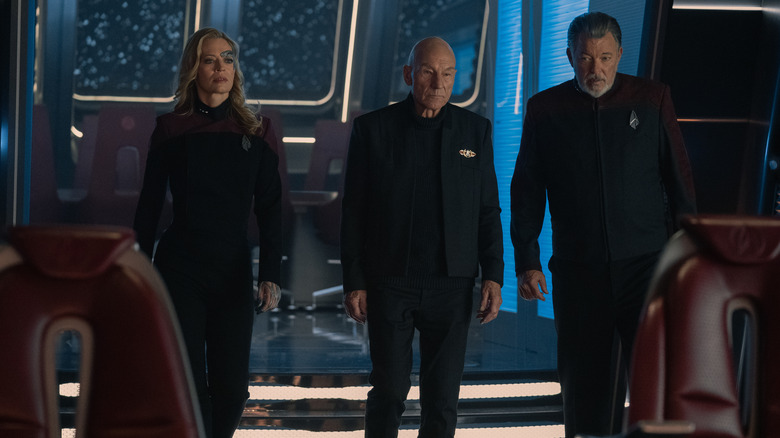
According to Matalas, Stashwick's curt acting style was perfect to communicate a mood of dismissal and general, callous disrespect. But, y'know, still professional. Matalas said:
"I think I said it just like that in the room and I go, 'Just imagine Captain Stashwick,' is what I said. So we immediately just ran from there, and there was never anyone else up for the role from that moment forward."
It seems that was before Stashwick was actually cast in the role. He was merely used as a guide for Matalas' writers' room. Indeed, the actor's name was used more often than the actual character's name. Luckily, when it came time to actually cast Capt. Shaw, Stashwick was available and willing. Fitting, as the character was modeled on him.
"I think a week later, I kept saying, 'Look, in the writers' room we keep saying Captain Stashwick.' And [other writers are] like, 'Great, I can't wait to see who plays him!' But a month later, when we came to casting, he got the call. There was never anyone else up for the role. It was written specifically for Todd. And I think you could feel it. I think it's what makes it special and I think that's why the audience is certainly responding to it, at least from what I've been able to tell."
Capt. Shaw is, to editorialize, a brilliant character. He's passionate and principled, but a self-described a-hole. Shaw used to be an engineer, so he prefers rules and technical specs to intuition, and is suspicious of warmth. Viewers may hate him, but they will love how rich and well-realized he is. Capt. Shaw is a highlight of the new season, and ambivalence-adoring Trekkies will have a grand time waiting for the moments when he displays genuine command brilliance.
Read this next: 13 Reasons Why Deep Space Nine Is The Best Star Trek Show
The post Star Trek: Picard's Terry Matalas On Creating 'A Different Kind of Captain' Just for Todd Stashwick [Exclusive] appeared first on /Film.
The Daily Stream: Ultraseven Combines Spies, Star Trek, And Superheroes
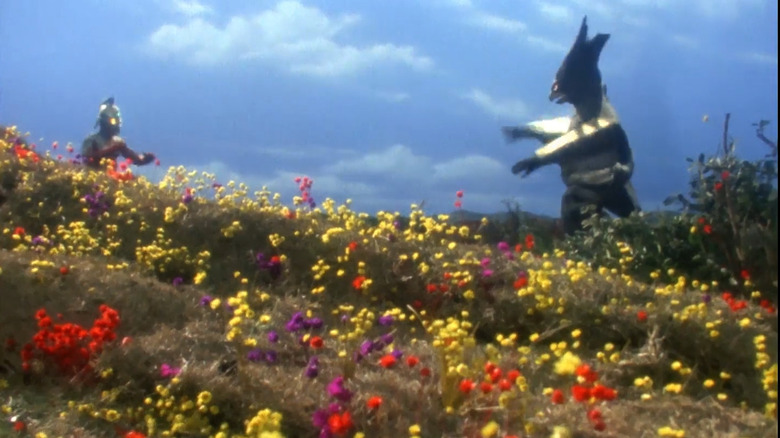
(Welcome to The Daily Stream, an ongoing series in which the /Film team shares what they've been watching, why it's worth checking out, and where you can stream it.)
The Series: "Ultraseven"
Where You Can Stream It: Tubi, Shout! Factory TV
The Pitch: One day while on patrol, the alien hero Ultraseven stops by Earth. Taking on the human identity of "Dan Moroboshi," he joins forces with the Ultra Guard to protect the planet from nefarious aliens that wish to conquer it. Each episode brings new and unexpected surprises. Thrill at the alien threat that crucifies Ultraseven in "The Seven Assassination Plan." Marvel at the craft of "The Marked Town," an impeccably lit episode in which aliens drive humans into a frenzy with laced cigarettes. Watch in horror as humanity battles Earth's undersea denizens, who only wish to be left alone, in "Ambassador of the Nonmalt." Meanwhile, "The 700 Kilometer Run" features Dinosaur Tank and it's exactly what you think it is. All these and more in "Ultraseven," a beloved sci-fi series that inspired all your favorite shows, movies, and games.
Why It's Essential Viewing
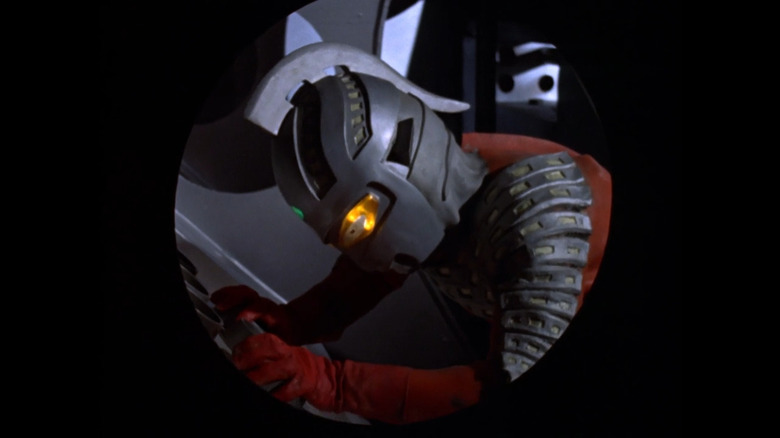
"Ultraseven" was intended to be an ending. "Ultra Q," which aired in 1966, inspired a science fiction craze through its melding of monstrous kaiju and "Outer Limits" style spookiness. Its successor "Ultraman" added a heroic, human-shaped alien to that formula, as well as a supporting organization called the SSSP (or Science Patrol). Both series were produced by Eiji Tsuburaya, the special effects wizard behind films like "Godzilla" and "Mothra." Audiences desperately wanted more of "Ultraman." But these shows were hugely expensive and time-consuming to make, even though Tsuburaya Productions had an extensive prop department to draw from. Plus, Tsuburaya and his team were artists. They weren't satisfied just making more "Ultraman." They wanted to make something that nobody had ever seen before.
Tsuburaya admired the style and sophistication of 1960s spy shows such as "Mission Impossible" and "The Man From U.N.C.L.E." He also adored the special effects of "Thunderbirds," a 1965 TV puppet drama featuring great planes, explosions, and miniature work. "Ultraseven" integrated these influences into the "Ultraman" formula. The villains of "Ultraseven" are alien invaders rather than simply unexplained phenomena. The Ultra Guard have access to advanced planes and technology but frequently find themselves in over their heads against dangerous foes. Ultraseven himself is able to remain human-sized rather than always growing huge. It's a fitting approach for a series intended to be a grounded, adult alternative to "Ultraman."
Showdown At 140 Degrees Below Zero
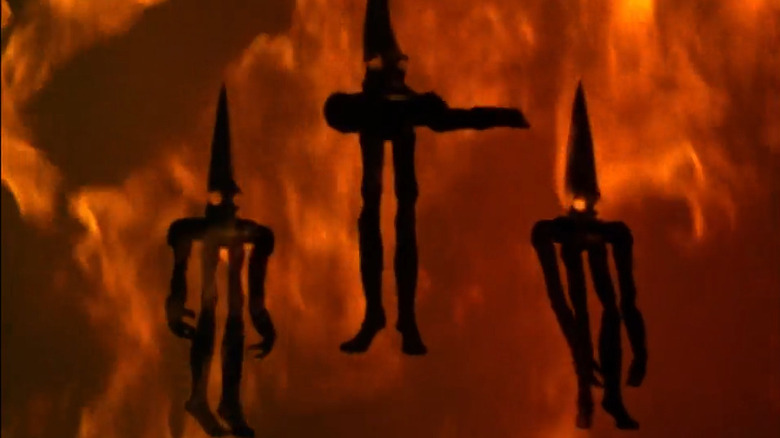
"Ultraseven" is not just a superhero show. It's a sci-fi show, operating in the same vein as "Doctor Who" and "Star Trek." Like "Star Trek," the characters are stock archetypes that navigate challenges with professionalism. Like "Doctor Who," "Ultraseven" exists in a malleable universe that shifts in tone and style depending on the needs of the episode. Some propose moral quandaries, like "Dark Zone" (which beat Jonathan Hickman's "Avengers" run to the punch by decades). Others, like "Escape Space X," conjure atmospheric alien worlds. "Ultraseven" has a beginning and an end, but the continuity is light enough that a curious viewer can pick and choose episodes as they wish.
But the series is at its best when it explores the physical and mental limitations of the Ultra Guard. In the fantastic 25th episode, "Showdown at 140 Degrees Below Zero," a snowstorm conjured by aliens shuts down the Ultra Guard's base as well as its heating. While Ultraseven struggles with his alien vulnerability to cold, his fellow soldiers and scientists risk their lives to restore the generators as their superiors argue over evacuation.
In the next episode, "Super Weapon R-1," the Ultra Guard test a powerful bomb on a seemingly empty planet only to find themselves responsible for genocide. The planet's last living creature flies to Earth to take revenge, stomping through ruins that resemble Nagasaki's Urakami Cathedral. The episode ends on a hopeful note, as Dan Moroboshi convinces the scientists to discontinue the bomb's production. "Ultraseven" is at least willing to challenge the assumptions of its all-powerful military even as it positions them as heroes.
Nightmare Of Planet No. 4
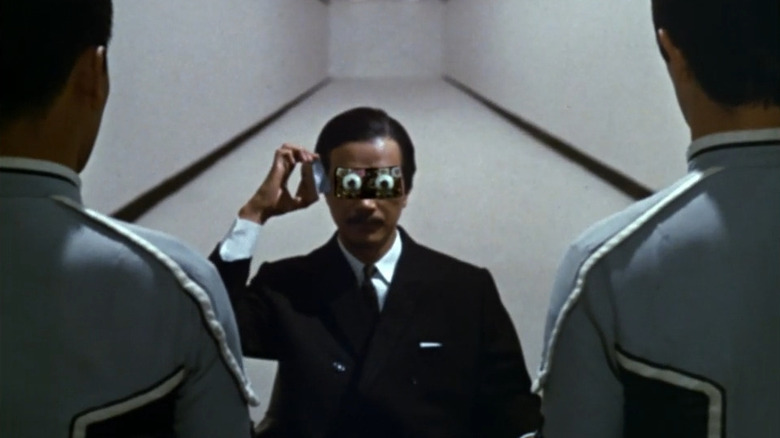
"Ultraseven" is also exceptional at being weird. The twelfth episode of the series, "From a Planet With Love," was banned in Japan for featuring a creature design inspired by nuclear bomb victims. The forty-third episode, "Nightmare of Planet No. 4," transports Dan Moroboshi and his colleague Soga to a dystopia run by machines. In the episode's most harrowing scene, the two of them witness human actors on a film set shot to death by the crew. At the end of the episode, of course, Dan transforms into Ultraseven and wrecks the machine city. The episode is framed within the series as a dream, too outrageous for even the Ultra Guard to believe. But the implication remains that there are forces in the real world far deadlier than "Ultraman" kaiju, with no Ultraseven to help us.
These two episodes and others were directed by Akio Jissoji, a filmmaker with roots in Japanese New Wave cinema. Jissoji helmed several episodes of the original "Ultraman," including the classic "My Home is Earth." Per Mike Dent at Zimmerit, his distinctive lighting and use of low/dutch camera angles were a big influence on Hideaki Anno, director of "Neon Genesis Evangelion" and the recent "Shin Ultraman." Jissoji was inspired by the ambition and adult slant of "Ultraseven" to take even greater risks with his episodes. When producers complained that "Nightmare of Planet No. 4" lacked a monster, Jissoji threatened to write a new script in which Ultraseven fought every single kaiju that had appeared in the series to that point (via Ultra Blog DX). The producers backed down, and the episode was released as is.
From Pokémon To Gridman
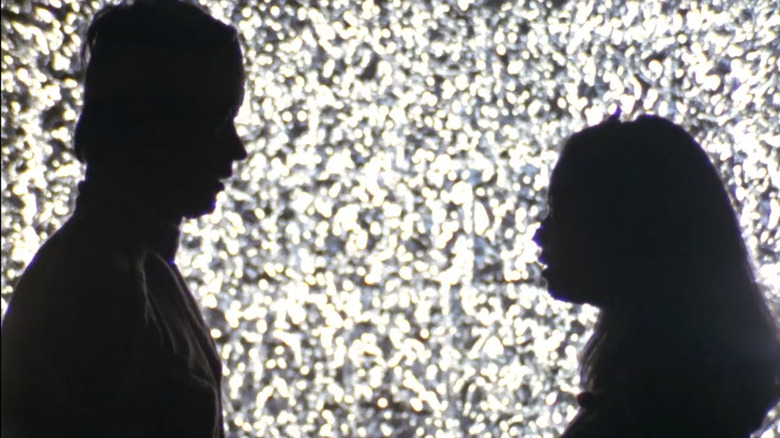
"Ultraseven" was not the immediate success that "Ultraman" was. But artists were watching and learning. Ultraseven calls upon friendly kaiju called "capsule monsters" throughout the series. Decades later, a man named Satoshi Tawajiri envisioned a video game called "Capsule Monsters" in which trainers stored powerful creatures inside of balls. We now know that series as "Pokémon."
The finale of "Ultraseven," "The Biggest Invasion in History," is similarly foundational. The drama, the scale of destruction, and the use of sparkling background lighting after Dan Moroboshi reveals his alien identity have been borrowed and repurposed in countless future productions, such as the Tsuburaya Productions-produced "SSSS.Gridman."
"Ultraseven" is a product of its time in many respects. The supporting cast is thinly developed. The focus on alien invasions and stakeouts cuts down on sheer episodic variety that makes the "Ultraman" franchise enjoyable. "Ultraseven" is best approached as a platform for ideas or cinematic craft instead of the character-based storytelling that drives modern television. Even so, you have to applaud the ambition of Eiji Tsuburaya and his crew.
Future tokusatsu serials -- even the best of them -- would be toy advertisements first and television second. "Ultraseven" was driven by artists whose number one goal was to make the best show they could. Years later, this approach would bring about the financial ruin of Tsuburaya Productions as a company. But in 1967, there was nothing else like it on TV.
Read this next: All 24 Pokémon Movies Ranked Worst To Best
The post The Daily Stream: Ultraseven Combines Spies, Star Trek, and Superheroes appeared first on /Film.
Army Of Darkness Is Everything Great About Director Sam Raimi Rolled Into One Package
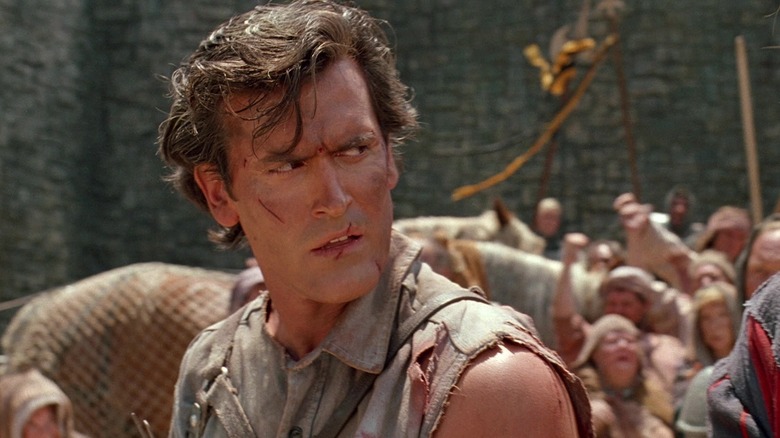
The "Evil Dead" trilogy is definitive proof that director/actor duo Sam Raimi and Bruce Campbell are a match made in bloody heaven. The original film of the franchise, 1981's "The Evil Dead" was Raimi's directorial feature film debut that was shot on a measly $375,000 budget, but would quickly earn itself cult status through its NC-17 rating and oppressive, nihilistic atmosphere. The film's premise was simple, following five college students who unleash something demonic and malicious during their stay in their isolated cabin in the woods. Once all hell breaks loose, Ashley "Ash" Williams (Campbell) is the last man standing amongst the wrath of the Deadites.
Years later, Raimi would return with "Evil Dead II," which centers the series once again on our survivor Ash, but also most notably brought the camp factor that the series would become known for. It's the fan-favorite of the entire franchise — delivering an over-the-top, hyper-stylized thrill ride in just a little under 90 minutes. In the final moments of "Evil Dead II," Ash is transported back in time and stranded in the Middle Ages, a wacky cliffhanger that sets the stage for the black sheep final entry of the "Evil Dead" trilogy.
This week marks the 30th anniversary of 1992's "Army of Darkness," and although it is the biggest departure in tone and setting for the franchise, it stands as a shining example of everything that's great about Sam Raimi's off-kilter and eclectic style. It's a pastiche of medieval fantasy aesthetics, it's a morbid take on slapstick comedy, but it's also true to the filmmaker's indie horror roots, and remains a wonderful genre-mashing flick in its own right.
Campbell Perfectly Sells Raimi's Unique Sense Of Humor
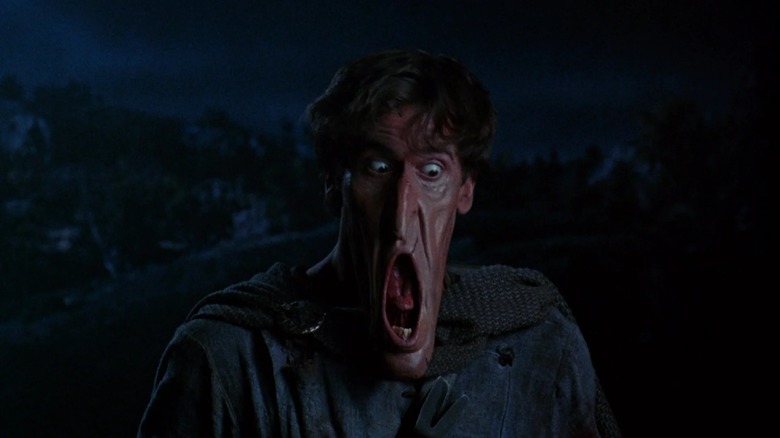
So how exactly is "Army of Darkness" the black sheep of the original franchise? For starters, the film largely departs from the oppressive and claustrophobic cabin in the woods setting of the first two movies and opts for something grander in scale, a mystical version of 1300 A.D.
Throughout the previous "Evil Dead" movies, Ash is never given a moment of peace. Here, we follow him on his "fish out of water" journey to survive the wrath of the Deadite army and search for the only thing that can transport him back home: the cursed book of the dead, the Necronomicon. Even though "Evil Dead II" was the sequel that elevated the franchise to camp horror status, "Army of Darkness" dials the absurdity of the series to 11. Ash's various antics in this fantasy medieval setting aren't just campy, they're downright cartoonish.
The juxtaposition between the juvenile, humorous moments of slapstick comedy and an arresting, gothic atmosphere is a joy to watch unfold. It might not be Raimi's scariest film, but he successfully demonstrates in "Army of Darkness" that both horror and comedic elements can be used in harmony to elevate one another.
Of course, it helps that Raimi's muse whom he built this entire trilogy off of is one of the best physical actors in the game. Bruce Campbell's performance in "Army of Darkness" is a career-best, somehow authentically embodying a strong, capable action hero and a bumbling doofus in equal measure. The Ash Williams we fondly remember in pop culture, with his "boomstick," chainsaw arm, and colorful personality is fully imagined here even more so than all other "Evil Dead" entries before it.
Raimi's Roaming Eye Is A Character In Itself
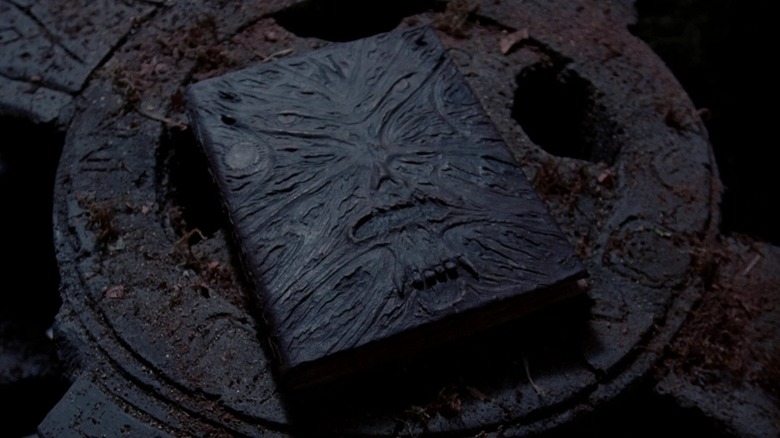
"Army of Darkness" is also by far the most expensive of the original trilogy, with Raimi coming right off the box office success of his film,"Darkman." The third "Evil Dead" film was shot in California for a budget of $11 million (more than three times the cost of "Evil Dead II"), and yet, it's still impressively chock-full of Raimi's scrappy, low-fi sensibilities.
Each entry in the "Evil Dead" trilogy feels like a deeper, gradual descent into madness. We as the audience are locked into Ash's state of mind, "Army of Darkness" feels like the apex of Raimi's chaotic, unhinged style. In a Raimi film, he commands the camera with such erratic swagger that he turns his eye into a character in its own right. All those Raimi trademarks: the crash zooms, and the free-flowing way the camera "floats" through the film's various settings as if it's a wandering spirit. These are ultimately the kind of sensibilities Raimi had developed as a low-budget independent filmmaker being creatively applied to something higher scale.
Knowing in retrospect that Raimi would briefly step away from genre filmmaking to pursue his next few features, "The Quick and the Dead," and "A Simple Plan," it feels as though Raimi threw his entirety into "Army of Darkness." A graveyard full of skeleton puppet hordes, over-the-top gore and violence, and a full-on Deadite war presented with his signature crude sense of humor makes this film so distinctively "Raimi."
An Unexpected, Ambitious Conclusion To The Trilogy
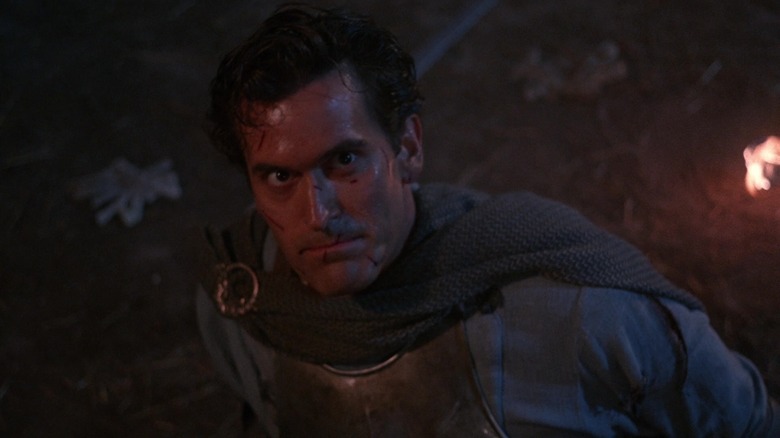
At the end of the day,"Army of Darkness" might not be the typical horror fan's answer when they're asked what the best "Evil Dead" film is, that honor is usually reserved for "Evil Dead II." While it's still well-admired, it's also much more divisive than the other entries. There are even four different versions of the film with tons of altered content, as well as two different endings that have their own packs of loyal defenders.
It's far from what fans initially expected from a third "Evil Dead" — the film has much less scare factor than "Evil Dead II," and is a large step away from the unique sadistic quality of the original "The Evil Dead." However, "Army of Darkness" is still a quintessential Sam Raimi film. The fact that it distinguishes itself so much from the rest of the franchise is not a weakness, it's an enduring strength that has allowed it to stay memorable for 30 years.
As the most expensive "Evil Dead" film at the time, "Army of Darkness" marked a transitional point in Raimi's career from an independent filmmaker to a studio collaborator. The result is a wacky ride that takes Raimi's off-kilter trademarks and uses them to bend the rules of the genre, from horror and comedy to supernatural fantasy. To us, that's pretty groovy.
Read this next: The 30 Best Zombie Movies Of All Time
The post Army of Darkness is Everything Great About Director Sam Raimi Rolled Into One Package appeared first on /Film.
9 Great Movies About A Cabin In The Woods
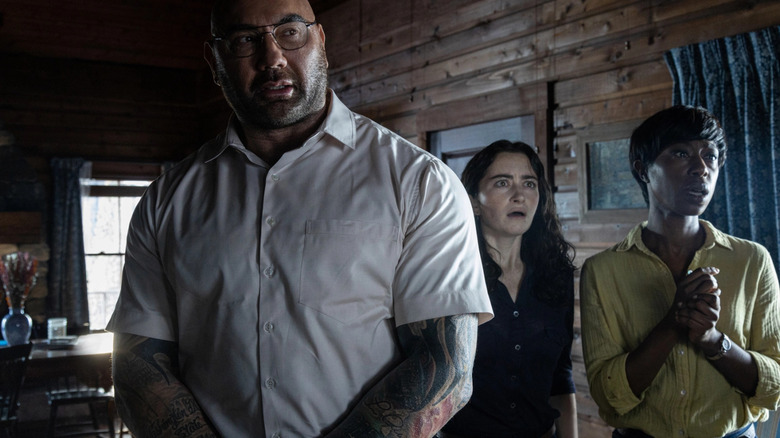
In M. Night Shyamalan's "Knock at the Cabin," a couple and their young daughter take a trip to a secluded cabin. Their peaceful vacation is interrupted by a group of strangers holding deadly weapons. It feels like a familiar hostage horror movie until the shocking revelation that the family must make a devastating choice to prevent the apocalypse.
"Knock at the Cabin" is just one of many films to use the cabin in the woods trope. This sequestered locale buried in the vast, mysterious woods is often the site of violence, confrontation, and hidden secrets in films — particularly the horror genre. It is a space where characters are forced to be together, and there is nowhere to run when they face danger. The wild, remote setting forces protagonists to confront life-altering circumstances and events. Often, these films are intimate with a small cast trapped in the cabin setting.
The cabin in the woods storyline does not just work for the horror genre, but also comedies or psychological dramas. This list explores how a variety of films utilize the setting to create captivating stories.
The Evil Dead Series
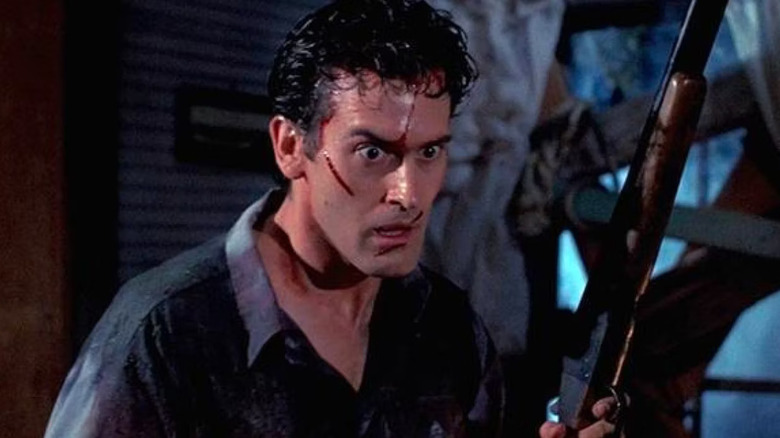
Sam Raimi's "Evil Dead" set the standard for the cabin in the woods narrative in the horror genre. The first film, "The Evil Dead," is about five young college students who plan to party in an old, abandoned cabin in the woods where they accidentally read from the Necronomicon and release ancient Kandarian demons that take over their bodies and souls.
Raimi's dynamic camerawork makes the small space of the cabin feel creepy and alive. He uses point-of-view shots from the demon trapped in the cellar door to give viewers the feeling of being hunted like Ash and his friends.
"Evil Dead II" is more of a requel, featuring a similar plot with amplified comedic elements. It fully embraces its new identity as less of a straight horror and more of a schlocky, B-movie, especially in the scene where Ash goes mad when he's left alone to fight the undead. Ash starts maniacally laughing, joining in with the deer head mounted on the wall and bouncing lamps, couches, bookshelves, and other objects that have come to life. It's as if the entire cabin is mocking him for being trapped in this hopeless situation.
The 2013 reimagining of the original classic has a dour aesthetic. While the original "The Evil Dead" cabin is dark and terrifying, Fede Álvarez's setting is lit in muted, drab colors that match the reformulated plot about a group of friends heading to a cabin to stage an intervention. There is little to no humor, and the gore is grimy and lacerating. In this film, the demons are petrifying with their rotting skin and piercing yellow eyes. The trailer for "Evil Dead: Rise," which releases on April 21, seems just as horrific — if not more so.
Honeymoon
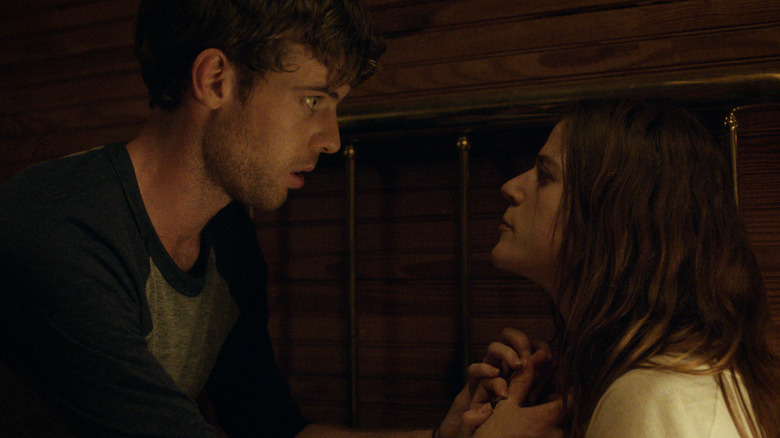
Cabins are typically a romantic spot for couples to enjoy each other in peace and quiet without any distractions. The horror movie "Honeymoon" takes the special post-wedding vacation and turns it into a terrifying experience. Newlyweds Paul and Bea are excited to celebrate their recent nuptials in a remote locale, but one night Bea goes missing. He finds her naked and confused in the middle of the woods. Was it sleepwalking or something more sinister lurking around the cabin?
Cinematographer Kyle Klutz bathes "Honeymoon" in a sickly yellow hue that represents Paul's fear and Bea's deteriorating mind after a strange sleepwalking incident. She slowly starts forgetting simple words or personal details about their relationship. In one startling scene, Paul discovers Bea mutilating herself.
Leigh Janiak's "Honeymoon" rapidly builds to an unnerving final sequence of body horror. The film uses the small, claustrophobic space of the cabin to confront the characters with their deepest psychosexual fears about penetration or having a child. Most of all, it touches on the deep anxieties couples have about losing their partner to unexpected changes that turn them into someone you no longer recognize.
What Keeps You Alive
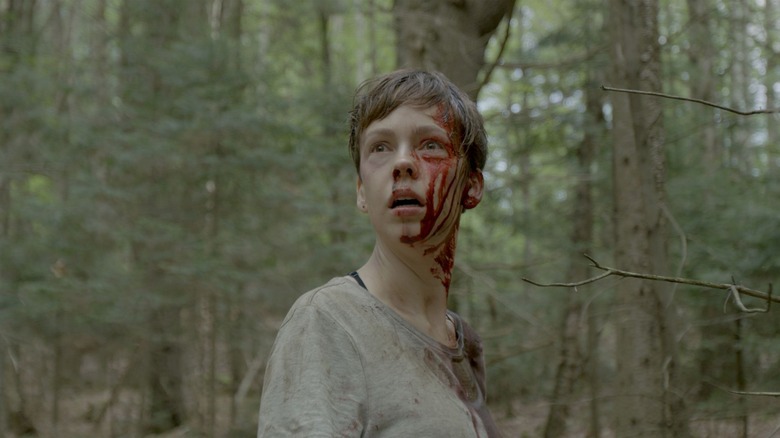
In "What Keeps You Alive," another couple travels to an isolated cabin for some relaxation and romance on their one-year anniversary. Much like "Honeymoon," Colin Minihan's film taps into a secret fear that couples have: What happens if you discover the person you love is not who you thought they were?
The revelations and intense chaos that follow are best left unspoiled. Minihan's camera is unhinged and moves quickly throughout the sprawling cabin and woods that Jackie knows like the back of her hand. He places the viewer immediately within the intense action by closely following the protagonist Jules as she runs for her life.
One sequence turns the quaint and cozy cabin into a twisted and evil space. Under the haunting glow of a black light, Jackie gingerly wipes up tiny splatters of blood, erasing all traces of the manic violence that recently occurred. "What Keeps You Alive" is a heart-pounding take on the familiar cabin in the woods narrative with a queer horror twist.
It Comes At Night
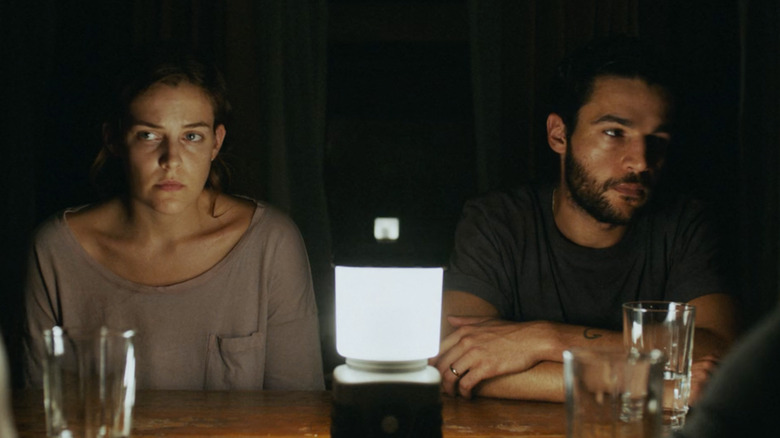
Trey Edward Shults' slow-burning "It Comes at Night" was unfairly lambasted by audiences after A24 marketed it as more of a traditional horror and hid its minimalist, psychological qualities. The trailer makes it seem as if there will be a frightening creature, a zombie perhaps, terrorizing a cabin-bound family. "It Comes at Night" shows that true fear comes from the unknown: the creeping distrust of others, paralyzing fear of what you can't see, and lack of empathy for people outside of your own family. It is this kind of paranoia and doubt that can turn humans into monsters.
"It Comes at Night" follows a resourceful patriarch named Paul who wants to protect his family from a deadly infection that has wiped out the world. His compassion for others is put to the test when a young family begs to seek refuge in his home. The methodical film depicts Paul's strict survivalist rules and the two families' struggles come together under one roof.
Much of "It Comes at Night" is shrouded in darkness because the family does not use electricity. The lack of light adds to the paranoia and suspicion that gnaws at the protagonists. They struggle to see one another clearly on both a visual and emotional level. The cabin itself is reinforced with wooden planks, plastic, and a singular double-lock entrance that is painted red as a warning to any visitors. It is a foreboding space that wants to keep others out for the preservation of those inside. The themes of paranoia, invisible disease, quarantine, and suspicion are even more relevant in our new COVID-19 world.
The Lodge
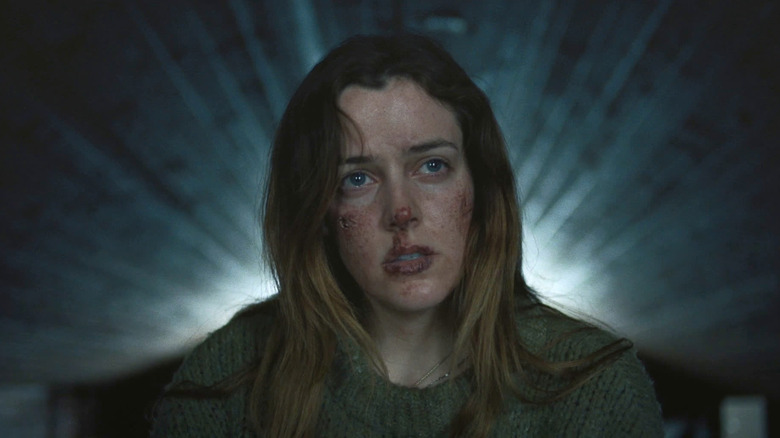
"The Lodge" has a cold, dreamlike quality that reflects the themes of mental instability and religious trauma. The psychological horror film is about a young woman named Grace who travels with her boyfriend Richard and his two children, Aiden and Mia, to a rural cabin during Christmas. The children are still mourning their mother's recent suicide.
They decide to play a trick on their stepmother-to-be, hiding her therapeutic pet dog, clothes, medication, and even the food and Christmas decorations. This causes Grace, who is the sole survivor of a cult mass suicide led by her father, to lose her mind and believe that she is in purgatory.
Directors Severin Fiala and Veronika Franz create an unsettling atmosphere that projects Grace's disturbed state of mind and fear of her surroundings. The reclusive cabin is not a source of warmth or comfort; it's surrounded by dark, bitter wood adorned with ominous crucifixes and mounted deer heads, and has a melancholy ice-blue tint. The main light source comes from the blinding white piles of snow outside. This almost monochromatic world seems ghostly and illogical, keeping the audience guessing what is real or imagined in the mysterious lodge.
Culminating in a spine-chilling ending, "The Lodge" adds another layer to the cabin in the woods narrative by exploring the damaging effects puritanism has on people.
Antichrist
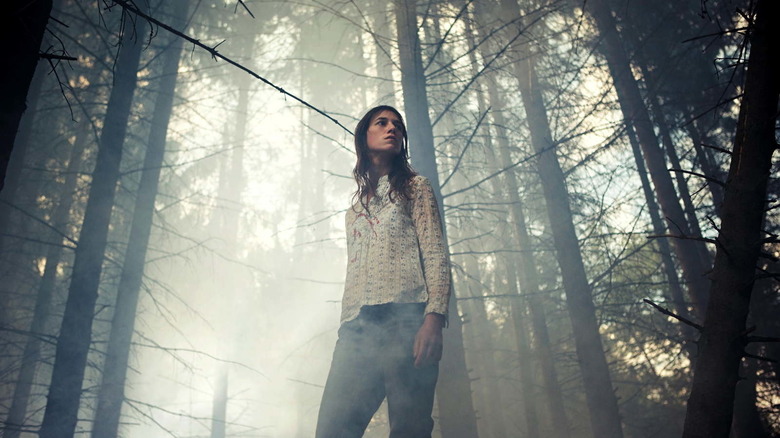
Like the majority of Lars Von Trier's work, "Antichrist" is philosophically dense and grim. A hidden cabin in the woods becomes a therapeutic refuge for a couple facing their rocky marriage and the accidental death of their son. The husband believes his wife will overcome her grief by facing her fears and spending time in the cabin they used to stay in as a family.
Trier nicknames the cabin "Eden," casting his unnamed main characters as Adam and Eve and the harrowing events of the film — torture, self-mutilation, sadomasochistic sex, and death — reinterpreting the Fall of man. Reflecting the main character's bereaved state of mind, the cabin is gray and muted. The surrounding forest is menacing with its rich, dark colors and terrifying sights of stillborn deer fetuses and foxes disemboweling themselves. This unruly setting is a stage for Trier to contemplate the meaning of birth and death which are intersected by sex.
"Antichrist" is a gruesome work that uses the cabin in the woods narrative to explore existential topics such as the unpredictable cruelty of nature and the effects of psychological trauma.
Land
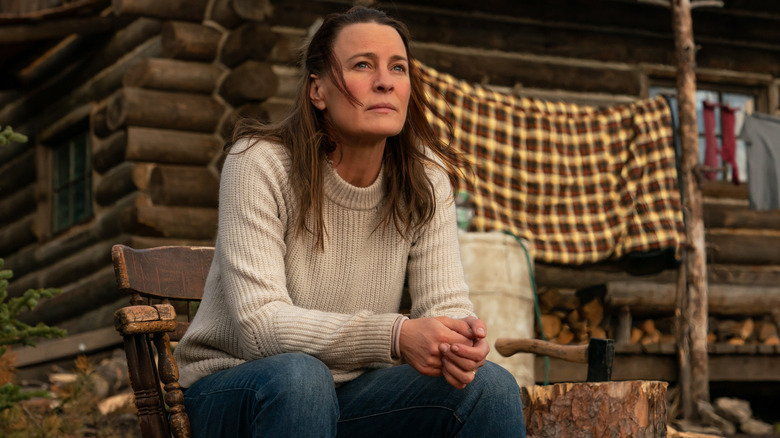
"Land" also deals with a bereaved mother. Robin Wright directs and stars in this slow-paced and contemplative film about Edee, a woman who lost her husband and son in an unspeakable tragedy. In order to process her grief, she completely removes herself from the world and endures life alone in a rural cabin where she once shared happy memories with her family. When she is saved by a kind-hearted stranger, she starts to open up again.
The cabin in this film is truly off-the-grid. It is essentially one small room with no electricity and Edee must travel to an outhouse to use the bathroom. Since there is no civilization nearby, Edee must hunt and fish for her food. Wright juxtaposes the rough darkness of the cabin with the lush landscapes of bright, green trees and massive mountains.
"Land" is a lovely character study about two deeply pained people who find a reason to live again. The film uses the cabin setting to teach a greater lesson about the human spirit. Mother Nature is both beautiful and terrifying; it can be rough and requires strength and tenacity. But much like life itself, it is not something you can handle alone. The film is a tender depiction of how important our connection to others is, an idea that really comes across in the emotional final act. Wright's film is a gentle change of pace from the typical cabin in the woods narrative.
The Trip
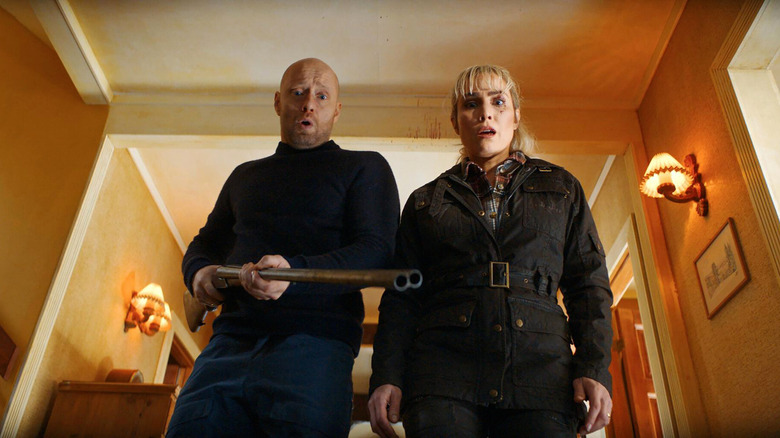
"The Trip" is bloody, mean, and at times downright ugly. The Norwegian dark comedy follows a director-actress husband and wife who head to a beautiful lakeside cabin for a relaxing vacation. But you can cut the tension between them with a knife. Eventually, we learn that they planned to murder each other during the trip and use a hunting or a hiking accident as an excuse for their spouse's death. Yet there are more dangerous foes lurking in the woods, and the estranged couple must join forces in order to escape the cabin and survive.
There are depictions of attempted assault in "The Trip" that are difficult to watch. This film has a nasty spirit; it greatly enjoys the grisly torture of its very unlikeable protagonists. Director Tommy Wirkola's camera whirls through the cabin in an ultraviolent cat-and-mouse chase with a lacerating sense of humor. What is so incredible about "The Trip" is how it keeps topping itself. Once you think it can't get any crazier, it does. "The Trip" is a true roller coaster ride that crashes into a hilarious and pitch-perfect ending.
Cabin In The Woods
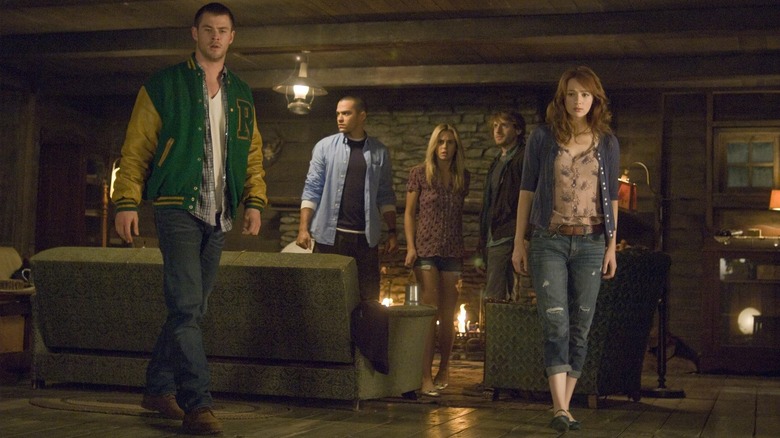
"Cabin in the Woods" parodies everything we know and love about the cabin in the woods narrative. Five college students spending their break in a remote cabin, inadvertently read incantations from a diary and summon the undead. Sound familiar?
Without giving too much away, the clever script by Joss Whedon and Drew Goddard contains numerous references and subversions of tropes from the horror genre. They make "Cabin the Woods" a meta-horror film that forces the audience to question the appeal of horror and why cabin in the woods movies are so captivating. The main characters are intentionally written as archetypes from well-known horror movies: The Virgin, The Fool, The Athlete, The Whore, and The Scholar.
Drew Goddard's "Cabin in the Woods" is the perfect movie to explore why the cabin in the woods narrative has such a hold on us. Through the satirical comedy and mind-blowing final twist, "Cabin in the Woods" makes audiences question why they enjoy watching young, attractive people suffer grisly deaths at the hands of twisted strangers or otherworldly evil.
Read this next: The Saddest Character Deaths In Horror History
The post 9 Great Movies About a Cabin in the Woods appeared first on /Film.
Humans 'May Need More Sleep in Winter', Study Finds
Read more of this story at Slashdot.
'OG Mark' Returns at Meta as Facebook Parent Gives Thousands of Staff Subpar Reviews
Read more of this story at Slashdot.
AMD Ryzen 9 7950X3D 3D V-Cache CPU Benchmarks Leak: 10% Slower In Multi-Thread & Similar Single-Core As 7950X

The first unofficial AMD Ryzen 9 7950X3D 3D V-Cache CPU benchmarks have leaked out within the Geekbench 5 database.
AMD Ryzen 9 7950X3D 3D V-Cache CPU Is 10% Slower In Multi-Threaded Performance Versus the Ryzen 9 7950X
The AMD Ryzen 9 7950X3D is the flagship & the first 16-core CPU to feature 3D V-Cache technology. The chip will incorporate a total of 32 threads, a total of 144 MB cache (64 MB CCD, 64 MB V-Cache + 16 MB L2), and a TDP of 120W. As for the clocks, the chip is rated at a base clock of 4.2 GHz which is 300 MHz slower than the standard 7950X but boost clocks are rated at the same 5.7 GHz. This should give us a hint at why the TDP is 50W lower versus the Non-3D part.

The AMD Ryzen 9 7950X3D was tested on an ASUS ROG Crosshair X670E HERO motherboard with 32 GB of DDDR5 memory. It looks like Geekbench 5 is unable to read the exact L3 cache for Ryzen 3D V-Cache "Zen 4" chips at the moment. In terms of performance, the CPU scored 2157 points in the single-core and 21841 points in the multi-core tests.
AMD Ryzen 9 7950X3D Multi-Thread CPU Benchmark (Geekbench 5)

The CPU ends up around 10% slower than the AMD Ryzen 9 7950X and Intel Core i9-13900K CPUs within the multi-core tests while offering similar single-core performance. The deficit in multi-core performance is to be expected considering the Ryzen 9 7950X3D doesn't has a lot of voltage or the thermal headroom to work with as the standard non-3D CPUs. The benchmark log shows that the chip maxed out around a peak 5.5 GHz boost clock which is slightly slower than the 5.7 GHz boosts that the 7950X non-3D can hit and explains the lower multi-core numbers.

Once again, the AMD Ryzen 9 7950X3D offering about 90% of the performance of the 7950X while delivering even faster gaming performance is going to be one insane deal for high-end users.
AMD compared the Ryzen 9 7950X3D CPU to Intel's top Core i9-13900K across several gaming and workload apps. The results show that the 3D V-Cache chip can offer up to 24% faster performance in gaming at 1080p with high image quality. Following are the game tests and the respective gains over the 13900K CPU:
AMD Ryzen 9 7950X3D Gaming Performance Test (via AMD):
- Watch Dogs Legion (1080p) - Up To 9% Faster
- DOTA (1080p) - Up To 11% Faster
- Rainbow Six Siege (1080p) - Up To 13% Faster
- Horizon Zero Dawn (1080p) - Up To 24% Faster

As we mentioned above, the 7950X3D chips have a different CCD configuration with one running at higher clocks and the other with conservative limits set in place due to the 3D V-Cache stacking. But that doesn't change the overall performance a lot even in workload apps as the chip can outclass a Core i9-13900K CPU in various tests as shown below:
AMD Ryzen 9 7950X3D Workload Performance Test (via AMD):
- File Encryption (VeraCrypt AES) - Up To 4% Faster
- 3D Graphics (PassMark 10) - Up To 11% Faster
- Adobe Premiere Pro (Playback) - Up To 17% Faster
- DaVinci Resolve (Extended Score) - Up To 24% Faster
- File Compression (7-Zip) - Up To 52% Faster

The AMD Ryzen 9 7950X3D and the Ryzen 9 7900X3D are going to launch later this month on the 28th for prices of $699 US and $599 US, respectively.
AMD Ryzen 7000 Raphael Desktop CPU Specs:
| CPU Name | Architecture | Process Node | Cores / Threads | Base Clock | Boost Clock (SC Max) | Cache | TDP | Prices (MSRP) |
|---|---|---|---|---|---|---|---|---|
| AMD Ryzen 9 7950X3D | Zen 4 3D V-Cache | 5nm | 16/32 | 4.2 GHz | 5.7 GHz | 144 MB (64+64+16) | 120W | $699 US |
| AMD Ryzen 9 7950X | Zen 4 | 5nm | 16/32 | 4.5 GHz | 5.7 GHz | 80 MB (64+16) | 170W | $599 US |
| AMD Ryzen 9 7900X3D | Zen 4 3D V-Cache | 5nm | 12/24 | 4.4 GHz | 5.6 GHz | 144 MB (64+64+12) | 120W | $599 US |
| AMD Ryzen 9 7900X | Zen 4 | 5nm | 12/24 | 4.7 GHz | 5.6 GHz | 76 MB (64+12) | 170W | $449 US |
| AMD Ryzen 9 7900 | Zen 4 | 5nm | 12/24 | 3.6 GHz | 5.4 GHz | 76 MB (64+12) | 65W | $429 US |
| AMD Ryzen 7 7800X3D | Zen 4 3D V-Cache | 5nm | 8/16 | 4.0 GHz | 5.0 GHz | 104 MB (32+64+8) | 120W | $449 US |
| AMD Ryzen 7 7700X | Zen 4 | 5nm | 8/16 | 4.5 GHz | 5.4 GHz | 40 MB (32+8) | 105W | $349 US |
| AMD Ryzen 7 7700 | Zen 4 | 5nm | 8/16 | 3.6 GHz | 5.3 GHz | 40 MB (32+8) | 65W | $329 US |
| AMD Ryzen 5 7600X | Zen 4 | 5nm | 6/12 | 4.7 GHz | 5.3 GHz | 38 MB (32+6) | 105W | $249 US |
| AMD Ryzen 5 7600 | Zen 4 | 5nm | 6/12 | 3.8 GHz | 5.1 GHz | 38 MB (32+6) | 65W | $229 US |
The post AMD Ryzen 9 7950X3D 3D V-Cache CPU Benchmarks Leak: 10% Slower In Multi-Thread & Similar Single-Core As 7950X by Hassan Mujtaba appeared first on Wccftech.
T-Mobile Is Dropping Its AutoPay Credit Card Discount in May - CNET
How Ukraine War Has Shaped US Planning for a China Conflict
A look at some of the lessons from the Ukraine war and how they could apply to a Taiwan conflict.
The post How Ukraine War Has Shaped US Planning for a China Conflict appeared first on SecurityWeek.
Brandon Cronenberg's Bizarre Body Horror Infinity Pool Was Inspired By A True Story
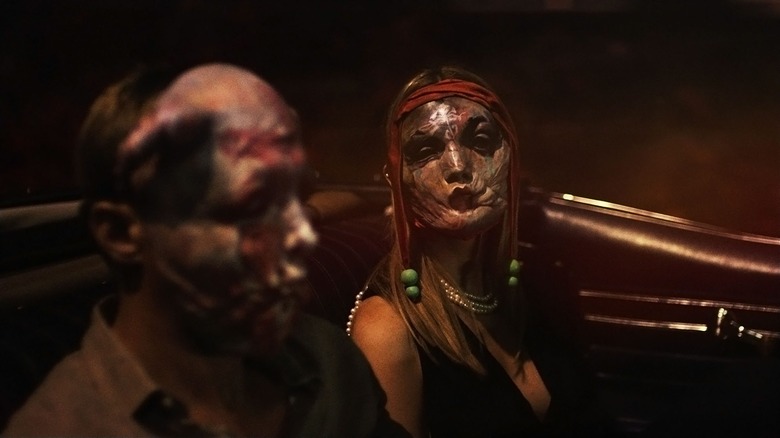
As much as he is indebted to his father, David Cronenberg's legacy as one of cinema's most beloved horror directors, Brandon Cronenberg ("Antiviral," "Possessor") has still managed to forge a path as a sleek and stylish modern provocateur in his own right. His newest outing, "Infinity Pool" has pretty much everything you're looking for from the Cronenberg name — it's a sexy, bloody, and debaucherous satire of the upper class and their nihilistic amount of apathy.
Set in an idyllic resort in the fictional country of Li Tolqua, "Infinity Pool" follows a novelist named James Foster (Alexander Skarsgård) and his wealthy wife Em (Cleopatra Coleman) who are on vacation searching for inspiration. They are soon joined by Gabi (Mia Goth), an aspiring actress (who coincidentally is a huge fan of James's only published novel), and her husband, Alban (Jalil Lespert). Together, the two couples go to dinner and spend time by the shore past the resort's explicit borders. On a drunken drive back to the resort, things take a turn for the worse as James accidentally runs over a local man, killing him.
Once James is arrested, however, he's given a choice by the government. He can either choose to accept the death penalty or for a significant fee, opt for an "alternative form of justice." Through a "doubling" process, those charged by the country can be fully cloned and watch as their duplicates are murdered for their crimes. Of course, James chooses to go forward with the process — sending him on a dark and obsessive path to uncovering Li Tolqua's doubling community and their excessive culture.
In the April 2023 issue of Empire magazine, Brandon Cronenberg shared that "Infinity Pool" was inspired by true events, specifically, one of his own personal vacations to an all-inclusive resort.
Inspired By A Real Vacation
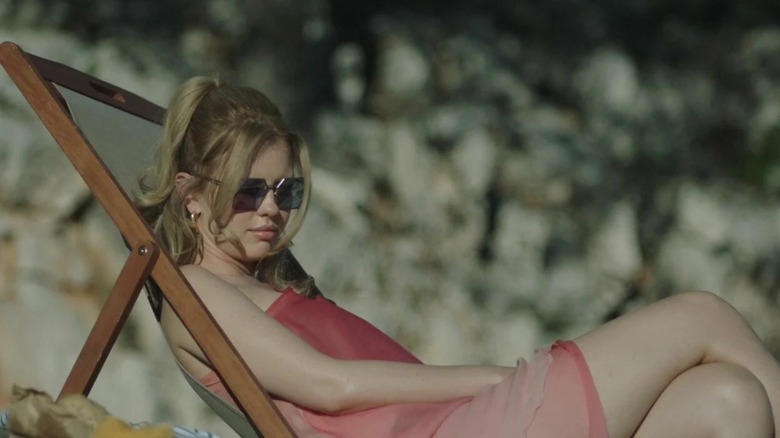
Well, the fictional setting and vibe of "Infinity Pool" is inspired by true events. But the act of "doubling" is purely fictional and is Cronenberg's own invention — the writer/director was very clear about that. However, as Cronenberg tried to conceptualize the rest of the film's setting around the concept of "doubling," he thought back to one "strange vacation" he took to the Dominican Republic:
"I'd been writing a short story about the doubling executions specifically. In the film's world, there's a death penalty for certain crimes, but if you're rich you can pay to be cloned and watch 'yourself' be killed instead. As I started trying to expand it into a film, I kept remembering this strange vacation to the Dominican Republic that I had many years ago. It was the only time I went to a traditional all-inclusive resort. I got talked into going there. It was totally weird because they would bus you in, in the middle of the night so you wouldn't see any of the surrounding area. You would be dropped off directly into a resort compound, which was surrounded by [a] razor-wire fence and completely contained. You weren't allowed to leave the compound."
As we're zeroed in on James's perspective as a man who married into money, Cronenberg draws attention to some things that break the illusion of tranquility and peace. In the first act of "Infinity Pool," it's established that the upper-class folk vacationing in the resort see Li Tolqua as "uncivilized" and "third-world." It is seen as a dangerous act to leave the confines of the resort, which is guarded by an electric fence. When James is arrested and sees the outskirts of Li Tolqua in the daytime, it's a whole different world from the resort bubble.
'A Weird Disneyland Version Of Reality'
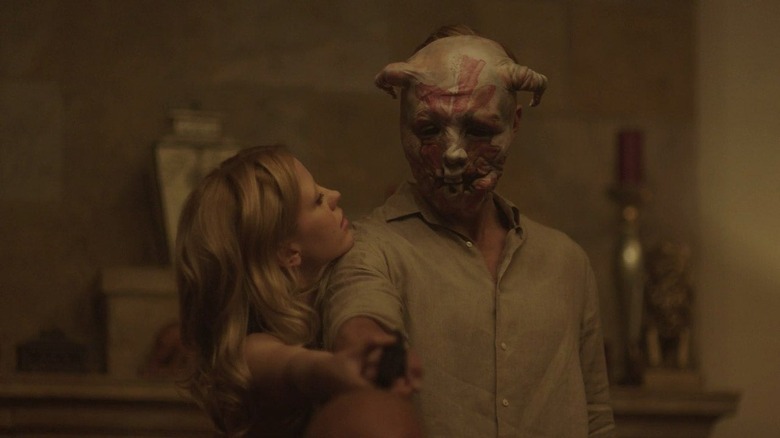
"At the end of this week, they bus you back during the day, and you see that just outside the compound there's this incredible poverty, people living in shacks," Cronenberg said. "And that contrast is incredibly disturbing and grotesque. It's almost like you were at the embassy for this nation of tourism. Or it was an alternate dimension that grew up in this host country."
Cronenberg shoots the resort in "Infinity Pool" with a surreal amount of sterility. It's too clean, too luxurious, and too generic to imagine why James is looking for "inspiration" here. But, that makes it a natural fit for a story about the rich and vapid. Cronenberg elaborated on the contrast between the resort bubble and the outside world:
"And as long as you're in the growth, you're experiencing a weird Disneyland version of reality where there's no culture and there's no history, or the world is just reprocessed in this really tacky resort way. I kept going back to that experience because it seemed like an obvious setting for a story about people living without consequences."
The Irony Of Critiquing And Depicting Wealth
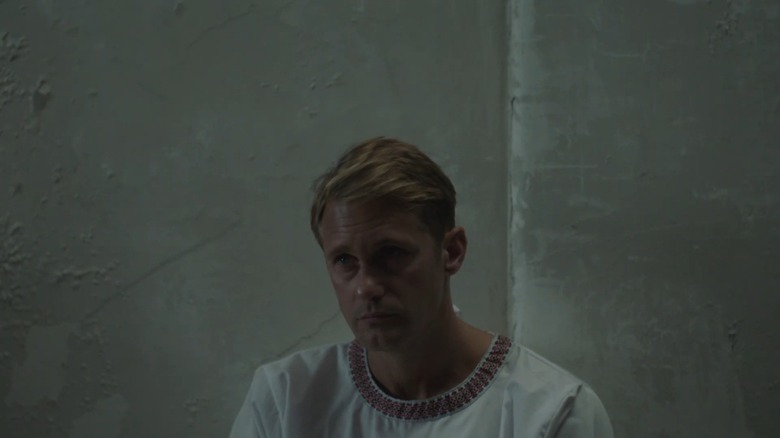
Ironically, the process of shooting "Infinity Pool" led to the cast and crew temporarily living in a resort in Croatia. In the process of making a film critiquing materialism and the insatiable wealth, Cronenberg and company partook in it. "It was almost like living this weird mirror image of the film because we were all there eating at the buffet and living at this surreal place," Cronenberg said. "And so we were sort of completely immersed and being the characters in a sort of insane way."
As shallow as Cronenberg felt he was in that moment, indulging in fruit and hors d'oeuvres in a controlled environment is not even half as criminal as the gratuitous actions his characters in "Infinity Pool" engage in, rest assured.
If you're interested in a grizzly tale of what the rich and powerful are capable of in a world without consequence, "Infinity Pool" is now available on VOD.
Read this next: Horror Movies That Even Horror Fans Could Hardly Finish
The post Brandon Cronenberg's Bizarre Body Horror Infinity Pool Was Inspired By A True Story appeared first on /Film.
FCC Reportedly Investigating if Internet Providers Exaggerated Coverage - CNET
Dinosaur Footprint Sets Record: 'Couldn't Believe What I Was Looking At' - CNET
Why Luke Skywalker Was Chosen As The Jedi To Train Grogu In The Mandalorian
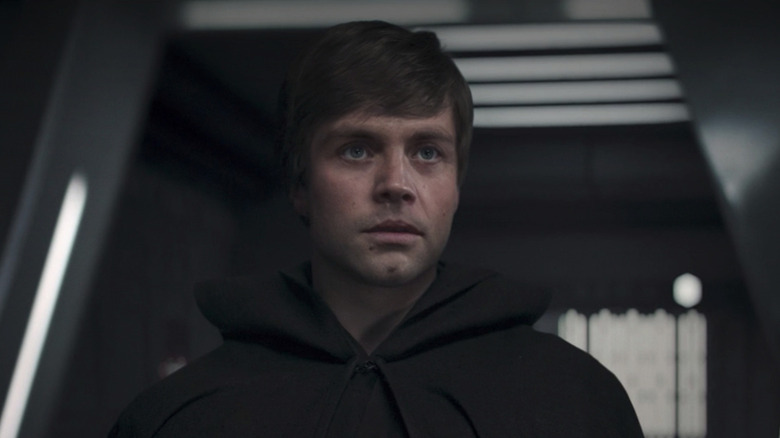
When "The Mandalorian" first premiered on Disney+, it helped reinvigorate "Star Wars" after a disappointing ending to the sequel trilogy. Not only did the series introduce the franchise to a whole new audience, it also gave us the adorable mascot we never knew we needed.
At first, the show's adventure-of-the-week format helped make this expansive universe more accessible. By tapping into "Star Wars" creator George Lucas' love for old-time serials, the show lets you dip in and out of the galaxy far, far away at your convenience, giving us fantastic stories, new locations, and cool characters, all without the need to spend hours reading Wookieepedia.
Things changed in season 2, however. "The Mandalorian" left behind the episodic format and started building towards something, all while bringing back wave after wave of fan-favorite characters in order to plant seeds for future seasons (or just entirely different shows). This culminated in possibly the worst moment of the entire series, when none other than Luke Skywalker made a surprise cameo to take the foundling formerly known as Baby Yoda (don't tell Rick Famuyiwa his real name) away to school and away from his adoptive dad.
It was a much-speculated scene that became a hotly disputed element in "The Mandalorian." Unsurprisingly, it wasn't a quick or easy decision to bring Luke back. It was, however, a logical one.
Luke Skywalker, A Legend
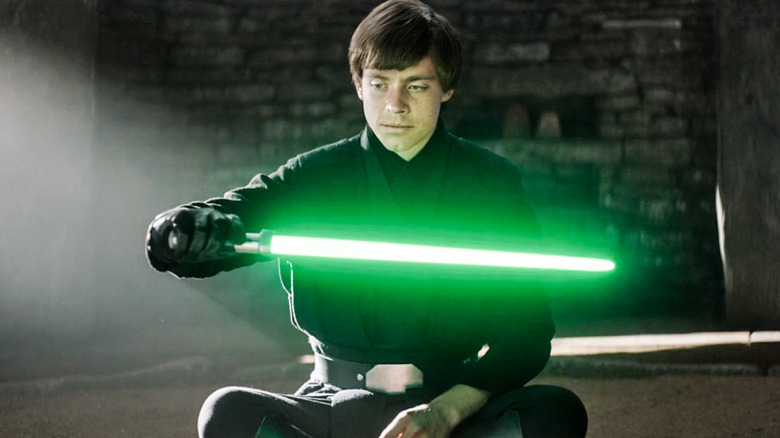
Luke's cameo is without a doubt the biggest reveal "The Mandalorian" has done to date, and you could even argue it's bigger than anything the sequel trilogy did, so it makes sense that there were some discussions about bringing the Jedi master back.
In an interview with Empire for the magazine's April 2023 issue, "The Mandalorian" producer Dave Filoni talked about making the decision to have Luke appear in the show. Unsurprisingly, Filoni thought of Ahsoka, but explained that "she can't take this kid on. That's just not what I have planned." Even when the idea of Luke came about, it wasn't as simple as just plopping him into the show. "[He's] this iconic character who's the center of the whole thing from when we were kids," Filoni said, "and if you want to bring that character in, you make sure that there's a good purpose behind it."
In the end, they did land on Luke, but not without reason. As Filoni explained:
"In this time period, he is the Jedi, he is the one person carrying on the legacy of what it means to be a Jedi, and perhaps improving on or having a new perspective on what it means to be a Jedi, compared to the prequel Jedi. And so he's seeking out students, building a new Jedi Order. So Luke finding Grogu made the most sense."
So, there you have it. Those who thought it was simple fan service, well, they aren't incorrect. But according to Filoni, the real character they brought back to please fans (more specifically, "The Mandalorian" creator Jon Favreau) had a bit more circuits in their body. "I told Jon, 'What's exciting is if we get Luke, we probably get R2,'" Filoni shared. "And Jon lit up. He loves R2."
It Is Time For The Jedi To End
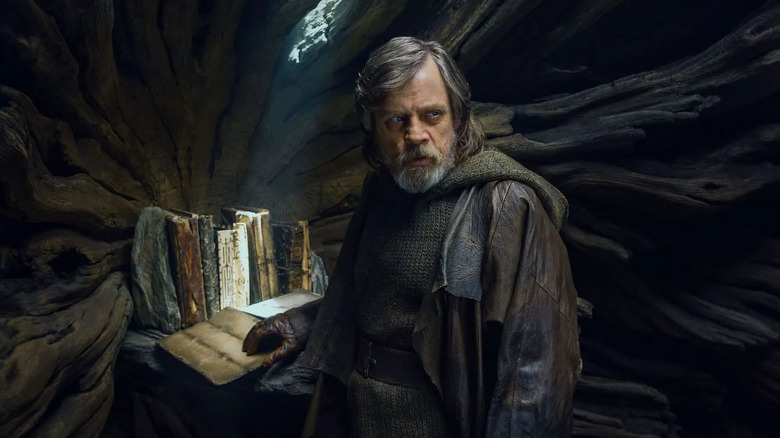
As Dave Filoni explained, Luke at this point in time fully represents the Jedi and the Jedi Order. It isn't Ahsoka, a former Jedi who left the Order behind, who comes for Grogu. It is not Cal Kestis, who was but a Padawan during the time of the Republic (and would be too close to what "Rebels" already did with Kanan and Ezra). And it certainly isn't Quinlan Vos, who was a bit of a maverick who bent the rules. No, it had to be Luke — the man who wanted to restore the Jedi — who would gather up Grogu and specifically show us why the Jedi are terrible.
The moment Luke arrives, the initial excitement over his cameo turns to anger when he tears apart Grogu's new family and takes the kid to a school where he couldn't see his dad. When we see Luke once again in "Boba Fett," he is not the cool Jedi legend, but the personification and continuation of everything that was wrong with the Order, a man so blinded by the weight of legacy and responsibility that he would repeat a cycle of pain that led to the destruction of the organization in the first place. This portrayal helps connect the Luke of the original trilogy with the grumpy and disillusioned Luke of "The Last Jedi" — a portrayal that apparently really shocked J.J. Abrams.
One of the best things George Lucas ever did with the prequels was to show that the Jedi were not just hunted down by the evil Sith, but that they were also a corrupt organization rotting from within that needed to end. Ugly CGI de-aging and blatant fan service or not, Luke's appearance helped further this point.
Read this next: Every Star Wars Project Currently In Development
The post Why Luke Skywalker Was Chosen As The Jedi To Train Grogu In The Mandalorian appeared first on /Film.
Can Star Trek: Picard Season 3 Retroactively Fix Picard And Crusher's Relationship?
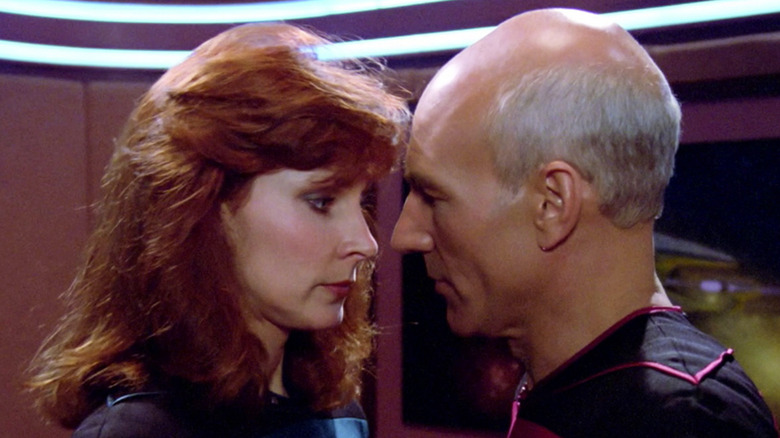
This post contains spoilers for the first episode of "Star Trek: Picard" season 3.
The first two seasons of "Star Trek: Picard" have worked to clean the skeletons out of the titular captain's closet. When we first reunite with Jean-Luc Picard (Patrick Stewart), something like 20 years have passed, and he's pretty much turned into the recluse that his old frenemy Q (John de Lancie) warned him against becoming in the "Star Trek: The Next Generation" finale. He's turned his back on — or, at the very least, just stopped checking in with — his oldest, closest friends. Only the promise of a new adventure is enough to convince him to pick up the pieces of his old life and form a new family from the connections that remain. Season 2 follows a similar path, but this time it's Q, again, encouraging Picard to get to the root of his intimacy issues. All that emotional overhaul has landed Picard in a place where he can actually admit that he cares for his loved ones (shocking, I know) — and it might just pay off big time in the final season.
"Picard" season 3 heralds the long-anticipated return of the "Next Generation" crew — and more importantly, of Dr. Beverly Crusher (Gates McFadden). Her kick-ass reintroduction immediately stirs up the unfinished business between her and Picard, who left things on a more or less platonic note after seven seasons of mutual pining on "The next Generation." Their withering relationship was one of the biggest missed opportunities of the series, one that "Picard" is now obliged to remedy in the final hour. It's all setting Picard up for a chance to apply what he's learned — but will he be able to fix one of the biggest mistakes from his past?
The Way They Were
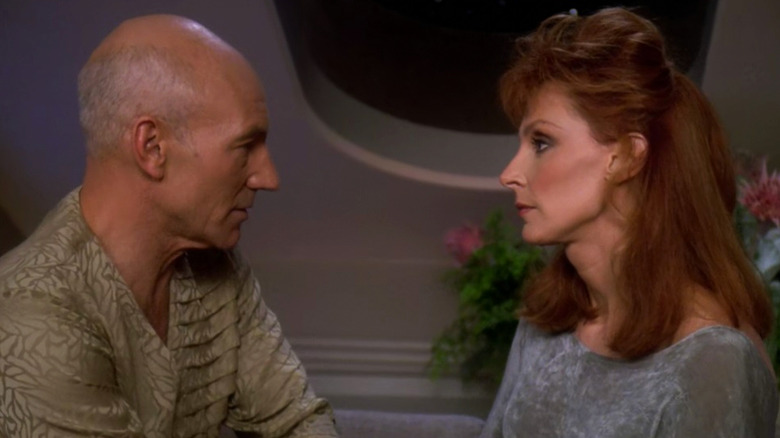
So what exactly happened between Picard and Crusher in "The Next Generation"? The short answer: Nothing, really. There was a time when Beverly Crusher was one of the most important people in Picard's life. They spent years as crew and captain, respectively, aboard the U.S.S. Enterprise — and before that, Crusher and Picard shared a connection via the former's late husband Jack. Picard later admits to harboring romantic feelings for Crusher even while she was married; the fact that she was married to Picard's best friend, however, obviously complicated matters. Crusher is widowed before the events of "The Next Generation," but Picard is so caught up in his guilt over Jack's death — for which he's partially responsible — and lingering loyalty to his late bestie that he buries those feelings beneath duty and ego.
"The Next Generation" notoriously danced around Picard and Crusher's romantic potential for seven long years. Even after that frustrating back and forth — and an alien encounter that made their unspoken feelings perfectly clear! — both decided they were better off as friends. Obviously that was a total cop-out, but as the voyages of this particular Enterprise came to a close, it seemed like fans would just have to live with the wasted opportunity.
A Few Loose Ends
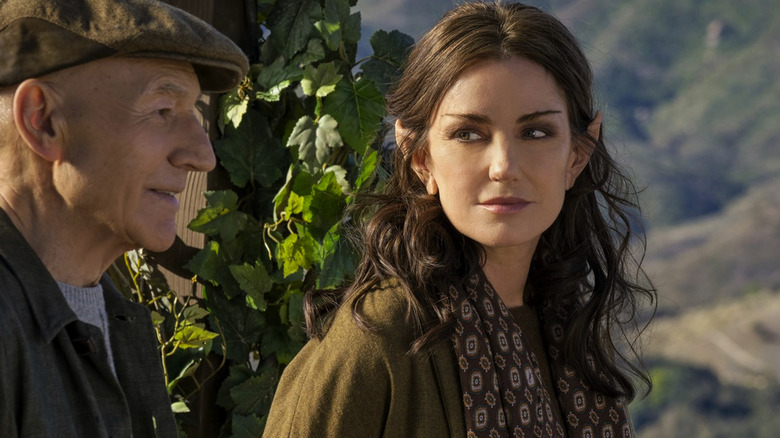
"Picard" represented a unique chance to bring Crusher back into Picard's life, but the series was pretty shrewd with which legacy characters were brought back into the fold. There's little mention of Crusher in the first two seasons of "Picard," but in season 3, we finally get a reason for her absence. Shortly after their last adventure in "Star Trek: Nemesis," Crusher pretty much ghosted the entire Enterprise crew. Picard even alludes to a more specific falling-out between himself and Crusher. "The last time I saw Beverly," he tells his Number 1, Riker (Jonathan Frakes), "the way we left it ... it was not on the best of terms."
Whatever went down between Picard and Crusher was obviously never resolved. But as remorseful as Picard seems now, can we really trust that he would have reconciled with Crusher given the opportunity? He hasn't exactly had the best track record in maintaining relationships, even with all the time in the world (as his exploits with certain characters have already made plain). Picard does have a better grasp on his emotions now than he ever did before, but it's all to the credit of another long suffering lady, Laris (Orla Brady). It was Laris that first encouraged Picard to acknowledge the feelings buried deep inside, right before Q took matters into his own hands. She and Picard have since settled into a comfortable — if not a little tepid — romance in Season 3. And it's nice to see Picard finally choose to let love into his life, but does Crusher's return signal a second chance at the love he was too scared to pursue before?
A Secret Kid?
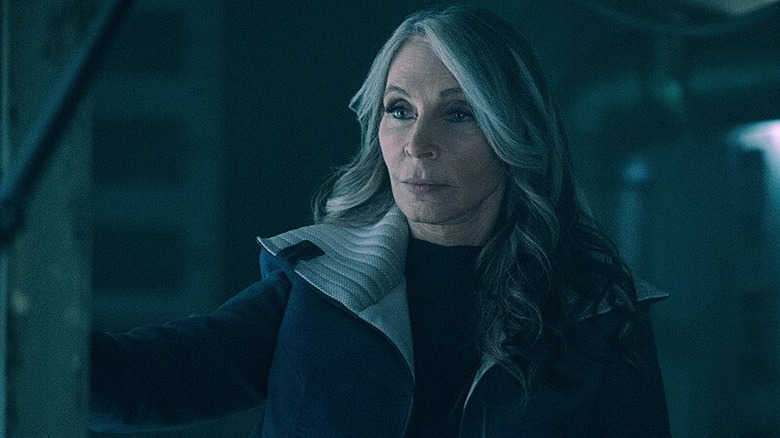
Bringing a lost love back into the mix — and just as our hero is finding new love elsewhere — all but promises the beginnings of a soapy love triangle. Naturally, the heart's gonna want what it wants, but it feels like a messy card to play this late in the game. Not saying that "Picard" shouldn't go there (I, for one, love mess) but it won't be the only thing complicating things for Jean-Luc this season. There's also the matter of Crusher's surprise son (Ed Speleers), with whom she's been on the run for years.
In sending a distress signal to Picard, Crusher wasn't trying to save herself from the shapeshifting aliens on her tail. She clearly wants her gruff, British offspring to fare better than she might. But why call Picard? Crusher had to have made some other allies in her 20 years post-Starfleet. She also doesn't even trust Starfleet anymore. Why would she involve her old captain — who, despite a few recent spats with the organization, is Starfleet through and through — unless it was absolutely necessary? Unless her son was maybe... his son, too?
Of course, this is all just hopeful speculation. But even if "Picard" proves us right, will that be enough to reverse course and give the fans what they've been waiting for? It's gonna take a bit more than a secret lovechild to fix over a decade of missed opportunities. In fact, I'm not sure there's anything "Picard" can do now that could make up for all that wasted potential. Maybe Q was right in suggesting that they could only ever end up as amicable exes. It's always been an issue of timing for Picard and Crusher — and as dismal as it sounds, there's a chance that time's already run out.
Read this next: 14 Underrated Star Trek: The Next Generation Episodes
The post Can Star Trek: Picard Season 3 Retroactively Fix Picard and Crusher's Relationship? appeared first on /Film.
David Dastmalchian Is Living The Nerd's Dream [Exclusive Interview]
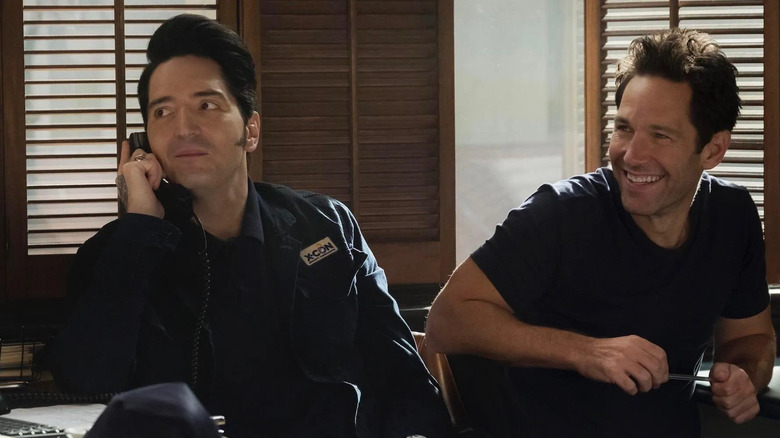
When David Dastmalchian tells me he's living the nerd's dream, I believe him. The avid horror fan and comic book reader (and comic book writer) is shaping up to have his most prolific year to date. In addition to writing and producing under his new production company, he has upcoming roles in a Stephen King adaptation, Christopher Nolan's "Oppenheimer," "The Boston Strangler," and two promising horror movies on the way: "Last Voyage of the Demeter" and "Late Night with the Devil."
On top of all that, Dastmalchian reunited with director Peyton Reed for Marvel Studios' for "Ant-Man and the Wasp: Quantumania." The actor doesn't reprise his role of Scott Lang's pal with the illustrious hair, Kurt Goreshter; instead, he plays a new character kept a secret until about a day or two ago. We won't spoil the new character, since Dastmalchian wants audiences to discover it for themselves. Recently, the actor took the time to discuss his upcoming year, his love of Vincent Price, and why he's living his nerdiest dreams.
Note: This interview has been lightly edited for clarity and brevity.
'If There Is One Thing That Thanos Could Not Destroy With The Snap...'
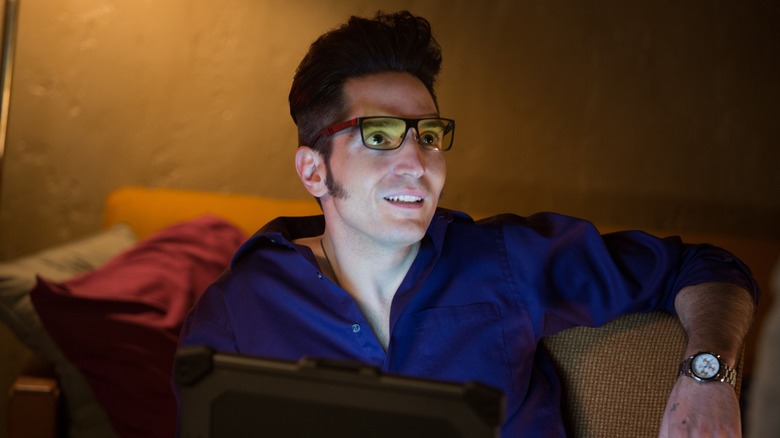
Was Kurt affected by the Blip? Remind me, did we see or learn what happened to him?
We didn't, but the reality is, what happened to Kurt was that his physical body was turned to dust for a number of years, but his hair never dissolved. If there is one thing that Thanos could not destroy with the snap ... he made Spider-Man go bye-bye. He made half of existence disappear, but he could not make Kurt's hair go away, and that's the power of Kurt's hair. Kurt is currently doing his thing. He's back, obviously. They were able to return everyone from the snap. He looks better than ever. If you saw "What If...?", which I think was so brilliant, Kurt unfortunately had a pretty sad end in that. But that's an alternate universe.
When you first got involved with "Ant-Man," did you and Peyton ever discuss where he hoped the series would go?
Peyton plays it close to the vest. He doesn't tip his hand as to what his vision is for the future, other than to give you enough clues as an actor and an artist to be able to give him what he needs. All I knew when he finished "Ant-Man and the Wasp" was he said to me, "If I get to make a third one of these, I can't wait to tell you where it's going and what's going to happen." He said it with this glint of just magic in his eye.
I'll never forget, because I was so proud of "Ant-Man and The Wasp." I thought it was such a great film and I loved what it said about family and about families ripped apart and what it said about overcoming our own fears. I loved it. It was such a special film and making it was such a special experience. When he finished, he told me, "If I get to do a third one of these, just you wait," so I sat and I waited. But it was hard to wait, because I always bugged him. I'd be like, "Tell me, tell me, tell me." He is a good secret keeper.
When did he finally tell you what he had in mind for you to do in this one?
I was in Berlin. He called me in, I want to say, summer, maybe fall of 2021. It was really amazing, Jack. I was having a terrible day.
You had a really tough shoot, right?
I was having a really tough shoot. I was in the middle of a really challenging creative process. I had lost my mother within the previous year and my father was dying. The world was in a questionable place, considering the pandemic and all the stress that we were all under and fear of the future. Peyton called me and he said, "Are you ready to hear what I'm doing?" I said, "I'm ready, man." He started telling me about this film that he was making, and I smiled like I hadn't smiled in quite a while, listening to him talk about it and hearing that signature Peyton Reed excitement in his voice.
I get choked up thinking about this. I'll never forget. I remember I was standing in a hotel room and pacing. I was getting so excited, just listening to him talk about what he was going to do and what everyone is about to see. Then, he told me that he wanted me to be a part of the telling of that story, and I was truly moved. I'm so grateful for him and I'm so grateful for my Marvel family, that I get to be a part of telling this really vital story to the MCU as a whole, but also Scott and all these other characters' journeys.
'Peyton Is My Lucky Marble'
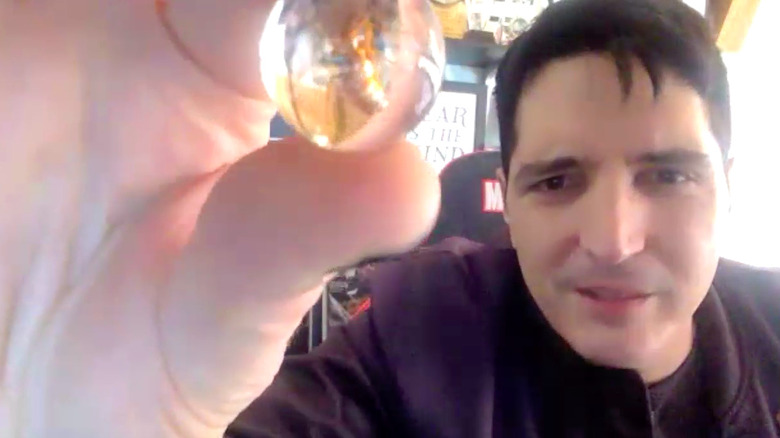
Your new role has mostly remained a secret throughout production, right?
I think that's still kind of a secret. I'm not trying to be coy about it. What I'm excited about is, without saying much about my character, the experience of just watching this film. Then, when you make the discovery of my appearance in it, hopefully it's an added fun part of the experience for you. One, I've never played a character remotely like the character I'm playing in this film. Two, I've never had as much joy in working as I did in playing this character. Now, that's not to say that the character wasn't challenging or demanding of me, but being back on a Peyton Reed set, being in the company of these amazing artists, getting to work on this was one of the most joyful experiences I've ever had working on a film.
I've had some f***ing joyful experiences. You know that. I love my f***ing job so much. I think about standing on the set of "The Suicide Squad," and I think about marching down LaSalle Street in "The Dark Knight," and I think about being a part of the majesty that was "Dune." Even my baby films, like "Animals" and "All Creatures Here Below" and these other films that I've loved working on -- but being back with Peyton, that was some of the most joy I've ever had. He put me into a special place as an actor that I needed to get back to. I went from working with him into a string of projects that ended up being all incredibly fulfilling, joyful, positive, creatively satisfying. I have this lucky marble and it's got a little ant in it, and I always have it with me because it brings me good luck. I'll show it to you. Here's my lucky marble.
Very cool.
You can post a picture of that. Peyton is my lucky marble.
Do you call the ant in the marble Peyton?
[Laughs] I guess I should, yeah.
Just an idea. But yes, throughout all your positive experiences, even just the idea of getting killed in the world of "Blade Runner," that must be a joy, too, right?
I was talking yesterday to my friend about "Blade Runner" and Sylvia [Hoeks], who killed me in that role. Watching her performance in that film, getting to be on a set with Denis [Villeneuve], which I've gotten the honor of getting to do three different movies now, and being filmed by Roger Deakins, what a f***ing life for this nerd, man. I didn't just hit the lottery. Someone gave me a roll of lottery tickets and every one's a winner. I can't tell you how grateful I am right now. It's surreal.
Your year is stacked. You also got to reunite with Christopher Nolan for "Oppenheimer," which looks like a gigantic indie. How is he as a communicator on set?
He knows what it is that he wants and needs, and he's very clear about helping you get there. He's an enigma to me. He's so extraordinary, his vision for things. I've gotten to work with him twice now. I just pinched myself. I can't believe that, but he's one of the human beings that I sit back and I'm in awe, because he has such an incredible mind for cinema, and he's just a very good communicator. That's plain and simple.
'I Think Of Vincent Price And How Powerfully He Could Use His Voice, His Eyes, His Gaze, His Delivery'
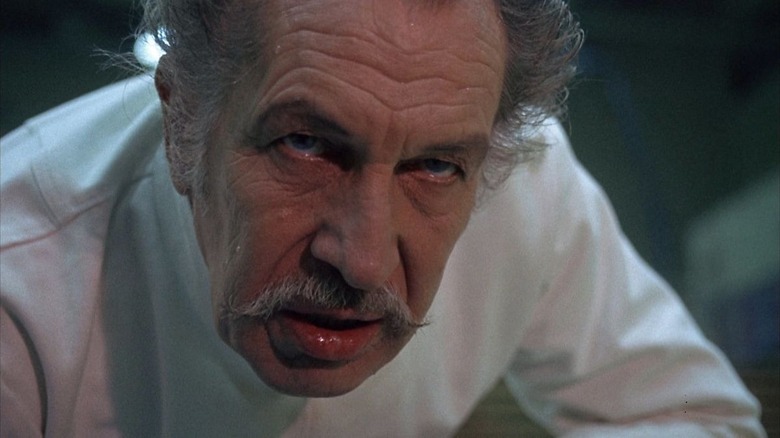
It's always nice to see Mr. Vincent Price behind you [in your office]. I just watched him in "Theater of Blood" for the first time.
So good. It's so good.
Amazing. He called that his best performance.
That, "Pit and the Pendulum," and "Usher." He was so good at everything he did. He was a master, man. I think that "The Abominable Dr. Phibes" is such a blast to watch, too. Yeah, he's the best, man.
Him, Christopher Lee, and those actors you love -- what about them and how they approached their work inspires you?
Look at the expressiveness that someone like Lon Chaney can bring to his work, even under this intense layering of makeup and wires and paint. There's something to me that's super inspiring about someone being in a movie that, for all intents and purposes, is a modern day folktale fable, that is, to most people, a tale told to just make you shiver and scream. There's a lot more to the genre than that, but I think a lot of people do go to this to see a good spooky picture, just for the fun of the roller coaster that it is.
Vincent Price or Lon Chaney or Boris Karloff or Christopher Lee or Peter Cushing brought the level of technical artistry and proficiency to bring these characters to life without any sense of irony. Some of the pictures they did that were comedic or more campy, there was a sense of irony, but in a large majority of the body of their works, you're looking at actors that brought their heart and soul to every frame and every line and every performance. To me, that's what made films like "Frankenstein" make me cry, what made Oliver Reed's performance in "Curse of the Werewolf" so captivating for me. I always think of Vincent Price and how powerfully he could use his voice, his eyes, his gaze, his delivery. All that training that he spent years developing on the stage to tell stories that maybe some people were like, "That's just silly."
I love it. I think it's beautiful, and it inspires me. Because when I show up to a film set, and let's say it's a superhero film or a monster picture and there's green screens or blue screens, or there's pumps of fake blood getting primed up to spray all over the place, I guess it would be easy to maybe take a step back and turn down the levels of engagement a bit, but I don't want the easy way. I want to do it the way my heroes did it, and I want to find my way to get lost into that stuff and tell stories that transport people no matter what the genre is.
Like Price, you have a background in theater. When actors like Brando came along, he decided to lean into his training in theater to stand out. For you, when you're making "Ant-Man" movies, how does your theater background help you?
The easiest way to describe it is to say I think every actor should spend time on stage. I had to figure out how to convincingly and effectively communicate lines of text from, let's say, a master like Tennessee Williams at two o'clock on a Sunday afternoon to an audience where I'm delivering a monologue, which is a direct address to an audience of people, many of whom would be staring at me, rapt with engagement, but many of whom were falling asleep or looking for candies in their bags or checking their phones, and that didn't mean s***.
So what? It didn't matter. I wasn't there to worry about whether or not they were digging in their purses or not. There was somebody out there in that house that was locked in with me, and my job was to tell that story and deliver those lines as they were written with as much proficiency as I could possibly muster under the guidance of whatever director had directed me in that play.
When I think about being on set, there's gaffers and electricians and boom operators and special effects artists and ADs running around, pulling their hair out, trying to keep us on schedule. There are giant blue screens and green screens because we can't build a giant forest for everything that we need when we're supposed to be in the jungle or whatever. We're in Dracula's castle. Well, sometimes we need to put that stuff up. To me, the power of my imagination, the power of believing what it is that I'm trying to do is all that matters. All those years of having to believe that I was in a realistic setting when I was actually in a small storefront theater in Chicago looking at 25 empty folding chairs, it's magic to me. It's the magic of the imagination.
'I Cannot F***ing Wait For People To See It'
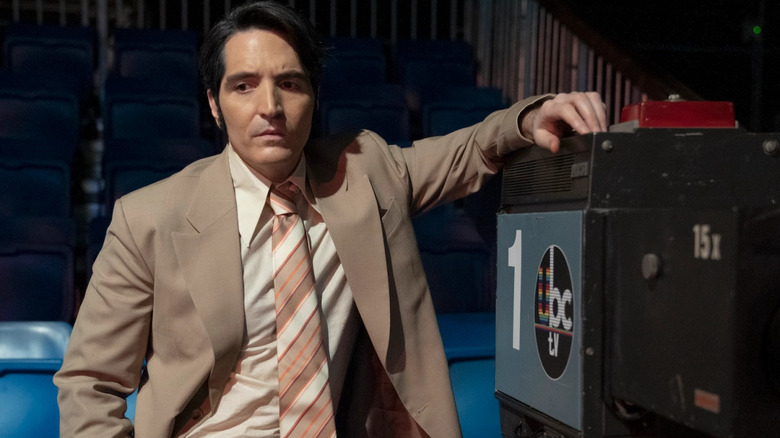
Talking about audiences, it's telling what movies they're showing up to see and what's doing well at the box office. Have the last few years, in particular, influenced how you write your own stories or think about an audience?
Well, I'm excited for people to -- February 8, we're going to be releasing in comic stores everywhere the newest volume of "Count Crowley," which is volume 2. I think if there are genre fans, comic book fans, readers out there who have at all engaged with any of the writing that I've been doing over the last 10 years of my career in film and comics, I think you'll see, hopefully, a shift in the way in which characters are interacting, not only with the inner turmoil that they're facing as individuals, but how that thread connects directly into the experiences they're having in the outside world. Because something I had come barreling down on me over the last several years of the difficult times that we faced in the world was how many of the really challenging battles that I was fighting inside of myself were so powerfully represented and observable in the world at large.
Many times the things that I needed to work on and strengthen and develop and heal in myself were ways that then I could turn around and give something of meaning to the world, hopefully have a positive effect on the world. I think that resonated with me, in a way, narratively more clearly than ever before over the last, I'd say, few years. I like to believe my writing has taken a step forward. I'm excited for these new projects that are coming that I'm putting together for people to see, because I do believe I'm not only maturing as a human being, but as a writer. I'm surrounding myself with great artists who are elevating me and pushing me to go further than I've ever gone before. I'm also surrounding myself with great friends and people and therapists who are encouraging me to go further and push myself into places that will help me grow as a person.
Creatively, what other experiences have you found exciting recently? You have so many movies coming out.
Talking about that joy that I got off of working with Peyton on "Ant-Man," it propelled me into the year that followed, which was highlighted with a big, bright raging roman candle ball of fury by the experience of making this film called "Late Night with the Devil," which I haven't gotten to talk about very much. There's a lot of surprises to that film. I will say that doing the amount of studying I had to do and getting into the skin of this guy, and understanding the pressure that he was under by being, say, second place to Johnny Carson, by knowing that his show was something that could potentially be given the axe at any moment, it was something I can relate to completely as an actor.
I'm sure you can relate to it as a writer. We know how that feels and what that did to him and the place that pushed him when everything leads up to that fateful night that the movie takes place in. Dude, I hope you're front and center and see it at SXSW. I haven't seen the movie yet, but if audiences get 10% of a jolt as much as I got out of making that film, then I think we've got something special. I cannot f***ing wait for people to see it.
'My Cat Is Just Trashing My Office Right Now'
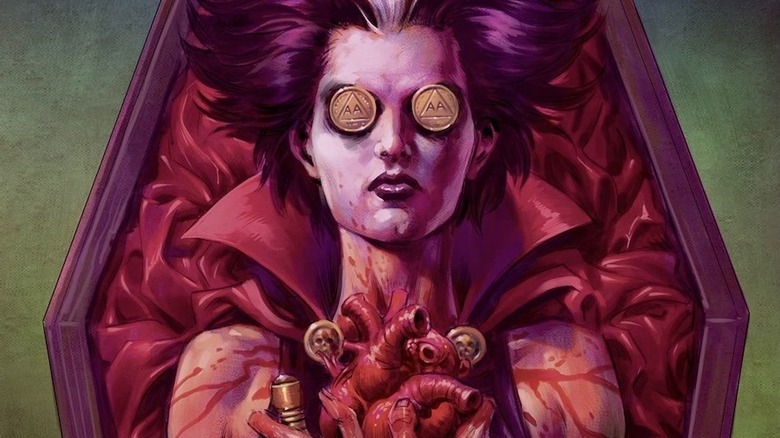
How's your to-do list looking for the year?
I just started my new one for 2023, and it is chock full of to-do's. Sometimes I look at it and it gives me the doo doos. Bubblegum! My cat is just trashing my office right now. Bubblegum, can you not right now? My God. She's got a to-do list. Her to-do list is to give me constant grief. I love you, cat. You're such a sweetie, but my God.
[Laughs] What do you have on your list?
I just launched my production company called Good Fiend Films. It's the culmination of ideas that I've been trying to manifest and bring together and materialize for my whole life. It's exploring all the complicated and difficult questions and ideas specifically through the lens of genre. I'm tackling horror, science fiction, and anything within the comic book and superhero realm, with all of the love that I have for character-driven stories and wrestling with all the big questions that make life so tricky and beautiful for me.
I sold a television series that I can't announce yet, but we've been working on it for about a year, and we'll be hopefully talking about that shortly. That is right in the space of genre. It's a mashup of a lot of things I love with a lot of people I love. Then, I've got two features that we are right now hopefully transitioning from development into pre-production over the course of the spring.
As you know, my comic book and publishing journey is so important to me. It's such an important space for me to tell stories. I'm going to continue to develop and grow Jerri Bartman's journey as Count Crowley into the future that I've always dreamed of for her. That future does include seeing her story told through the lens of the camera.
That's great.
That's a project we're working on at the time, and then I've got a couple new comic book projects that I'm going to be able to announce hopefully within the next six months. My to-do list right now is stacked. On top of it, most importantly, is just being aware of and doing my best to maintain my mental health and continuing my journey of sobriety and trying to be the best husband that I can be and the best father that I can be and the best friend that I can be and the best citizen that I can be.
I want 2023 to be this really explosive year for me, because I've worked really hard towards this moment. It's a year that's going to have a lot of cool celebrations, because there's a lot of cool things that are going to be coming out -- movies and books I've helped work on. But also, with that kind of energy comes an opportunity to try and dig back into myself and look at what it is that's working for me, but also what are the things that I could improve upon to elevate myself as a human.
"Ant-Man and the Wasp: Quantumania" is in theaters now.
Read this next: The 20 Greatest Human Villains In Movie History
The post David Dastmalchian is Living the Nerd's Dream [Exclusive Interview] appeared first on /Film.
Forget Milk and Eggs: Supermarkets Are Having a Fire Sale on Data About You
Read more of this story at Slashdot.
Bruce Campbell Prefers The Original Army Of Darkness Ending
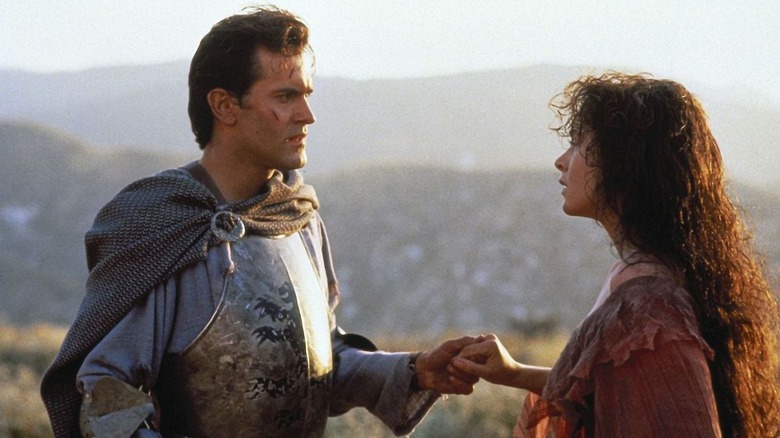
As has been previously discussed in the pages of /Film, Sam Raimi's 1993 slapstick horror comedy "Army of Darkness" notoriously had four different cuts. The version that ran in theaters in the United States was a trim 81 minutes and was rated R, most likely for a single scene where a human being is transformed into a blood geyser. The version that made its way onto TV was not rated but used supplemental footage to pad the running time to 88 minutes. That was also the length of the film's international release, which kept in some of the film's gorier scenes as well as its original ending. The longest version of "Army of Darkness" is a 96-minute director's cut, which includes mostly everything, original ending included.
It's worth pausing to note that Ash, played by the brilliantly funny Bruce Campbell, is a complete a-hole in "Army of Darkness." Starting in "The Evil Dead" (1981) and surviving "Evil Dead 2: Dead By Dawn" (1987), Ash moved from being a mild-mannered college student, to being a dumb, comically rude jerk. As the character survived more and more preposterous monster attacks, his basic intelligence fell away and his ego expanded. His rudeness is why audiences don't much mind watching him being abused, Three Stooges style, by walking rubbery skeletons. The worst things to happen to Ash in "Army of Darkness" are the results of his own dumbness. The army of the dead, for instance, only attacks when Ash misspeaks a magical spell. It's telling that the villain of the film is an evil Ash doppelgänger also played by Campbell.
The original ending was the "unhappy" ending and, according to the "Army of Darkness" commentary track, Campbell's favorite.
I Slept Too Long
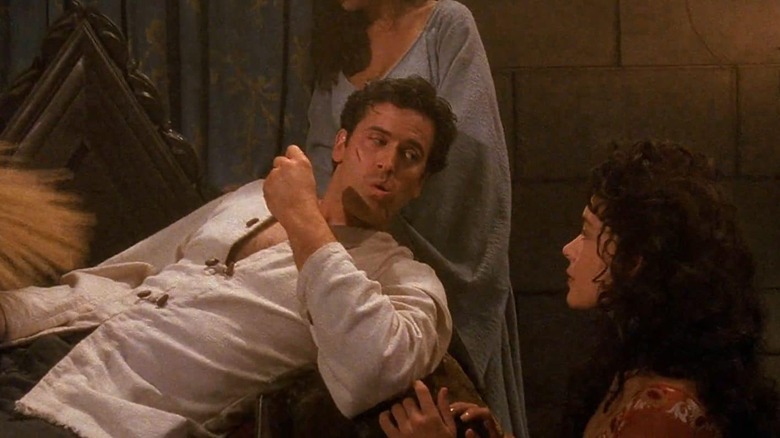
The U.S. theatrical ending is a "happy" ending, showing Ash in an action sequence and ending on a moment of triumph. Ash, having been displaced to the 14th century, finds himself back in his own time, still working a crappy retail job at a big box store. Of course, he misspoke the magic words that brought him back to the 20th century, so he also has to fight a hag monster. He kills the monster with about 50 shotgun rounds and kisses a nearby peer in victory. "Hail to the king, baby," he says.
The unhappy ending that Campbell preferred was quite different. In that ending, Ash was given a magical elixir that was to send him forward in time one century for every drop he swallowed. He pushed his car into a cave and drank the potion as instructed. He, however, miscounts the number of drops and swallows one too many. He awakens with a long beard and covered in dust, stumbles out of the cave, and sees that the world has been completely destroyed by some unknown conflagration. The final shot is Ash, in complete despair, wailing to the heavens that he slept too long. the poor dope can't catch a break. "Evil Dead IV" would have potentially been a post-apocalypse thriller.
On the commentary, Campbell had the following to say:
"In many cases this was referred to as the 'alternate ending,' but there's no such thing. This is the original ending ... I will defend this ending to the end of my days, because it's not about depressing. It's about appropriate. I think the ending is appropriate. And I think this sequence is very cool. It's very sci-fi and it gave a good lead-in to what would or would not become part IV."
The Appropriate Ending
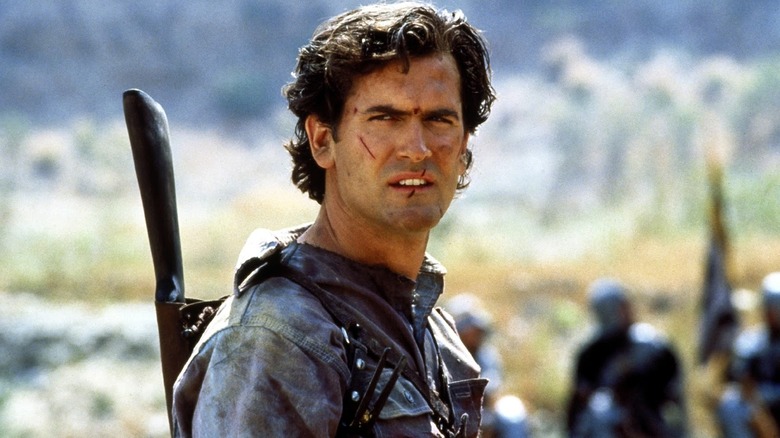
Campbell also noted that the cave they shot the original "Army of Darkness" ending in was also used in 1966 as the exterior of the Batcave in the "Batman" TV series. It's in a place called Bronson canyon. There are hikes one can take in Southern California to go see it. No, the actual Batcave is not inside. Campbell also just likes the original ending because of its look. He comments on the fact that the character changes positions a lot, the seasons pass, and the music becomes weirdly beatific. Just on a visual level, it's nice to look at. Then there are distant screams. Campbell also noted his character's utter idiocy. He said:
"This is where you get your character back, Sam [Raimi]. The idiot who is so easily distracted that he miscounts six lousy drops. [...] The poor sap. He slept too long."
Campbell has gone on record in the past about how much he would have personally hated meeting Ash in real life. He compared the character, negatively, to Donald Trump, and feels him to be a dumb blowhard. For Campbell, Ash getting his comeuppance was poetic. A character like Ash shouldn't have triumph. Life should be hard. It certainly shook out that way, as Campbell no doubt survived being splattered with untold gallons of fake blood in his tenure as the character. In 2018, the Starz TV series "Ash vs. Evil Dead" came to a close, and Campbell said that he was, in no uncertain terms, totally done. At age 64, he doesn't have the prowess to fight monsters anymore.
Ash may have ended badly, but Campbell stepped out with grace.
Read this next: The 31 Scariest Movie Scenes Ever
The post Bruce Campbell Prefers the Original Army of Darkness Ending appeared first on /Film.


